How Fast Are Speed Boats: Speed Boating Performance Guide
Speed boats, with their sleek design and powerful engines, evoke a sense of exhilaration and adventure on the water. From racing boats to luxury cruisers, these watercraft come in various shapes and sizes, each engineered for specific performance levels. If you’ve ever wondered just how fast speed boats can go and what factors influence their speed, you’re in for an enlightening ride.
In this comprehensive guide, we will delve into the world of speed boating to uncover the secrets behind their impressive velocities. Whether you’re a speed enthusiast or simply curious about these high-performance vessels, join us as we explore the factors that determine the speed of speed boats and unveil the thrill of chasing the horizon on the open water.

Various Types of Speed Boats Available in the Market

Speed boats encompass a diverse range of watercraft, each crafted with distinct designs and propulsion systems to achieve specific speed goals. Let’s explore the different types of speed boats available in the market:
- Powerboats: Powerboats are the most common type of speed boats and come in various styles, such as bowriders, center consoles, and cuddy cabins. They are propelled by internal combustion engines, typically using gasoline or diesel fuel. Powerboats are versatile and well-suited for recreational activities like waterskiing, wakeboarding, and leisure cruising.
- Jet Boats: Jet boats utilize waterjet propulsion instead of traditional propellers. Water is drawn through an intake and expelled at high speed through a nozzle, propelling the boat forward. This design allows jet boats to operate in shallower waters and provides increased maneuverability, making them popular for river and shallow water use.
- Hydroplanes: Hydroplanes are specialized racing boats designed for high-speed competitions. They have a distinct hull shape, often featuring a stepped design to reduce drag and improve stability. Hydroplanes can achieve astonishing speeds and are commonly used in events like hydroplane racing and drag boat racing.
- High-Performance Boats: High-performance boats are custom-built vessels designed for maximum speed and agility. They often have powerful engines, lightweight construction, and advanced hull designs to minimize drag and enhance performance. These boats are favored by thrill-seekers and racing enthusiasts for their exceptional speed capabilities.
Each type of speed boat is engineered to cater to different water conditions and boating preferences. Whether you seek the thrill of racing, the versatility of recreational activities, or the agility to navigate shallow waters, there’s a speed boat designed to meet your needs and ignite your passion for high-speed adventures on the water.
Key Factors That Influence the Speed of a Boat
The speed of a boat is influenced by a combination of factors that work in unison to determine its maximum velocity. Understanding these key factors can shed light on the thrilling world of high-speed boating:
- Engine Power: The engine’s horsepower and torque play a pivotal role in a boat’s speed. A more powerful engine can generate greater thrust, propelling the boat forward with more force. High-performance boats often boast powerful engines to achieve remarkable speeds.
- Boat Weight: The weight of the boat, including passengers, fuel, and equipment, affects its buoyancy and overall performance. A lighter boat experiences less resistance and can reach higher speeds with greater ease. Manufacturers often use lightweight materials to enhance a speed boat’s performance.
- Hull Design: The shape and design of the boat’s hull greatly impact its speed capabilities. A sleek and aerodynamic hull reduces drag, allowing the boat to glide through the water more efficiently. Hydrodynamic features like stepped hulls and tunnels can further optimize speed and stability.
- Water Conditions: Water conditions, such as wave height, currents, and wind, can significantly influence a boat’s speed. Rough waters and strong currents create resistance, limiting the boat’s velocity. On the other hand, calm waters provide optimal conditions for achieving top speeds.
The interaction between these factors can result in varying boat speeds. For instance, a boat with a powerful engine may achieve impressive speeds in calm waters, but its performance might be hindered in rough conditions due to increased resistance. Similarly, a lightweight boat with an efficient hull design may maintain high speeds across a range of water conditions.
Boat designers and enthusiasts carefully consider these factors to create vessels that excel in specific environments and meet the performance expectations of different boating activities. The perfect combination of engine power, boat weight, hull design, and water conditions can unlock the thrilling potential of speed boats and provide boaters with an unforgettable and heart-pounding experience on the water.
5 High-Performance Boats Designed to Achieve Remarkable Speed Records
High-performance boats are the epitome of engineering excellence, pushing the boundaries of speed and agility on the water. These extraordinary vessels have set numerous speed records, earning their place in the boating hall of fame. Let’s explore some iconic speed boats and their record-breaking achievements:
- Bluebird K7: The Bluebird K7 is an iconic hydroplane boat that achieved legendary status in the boating world. Piloted by Donald Campbell, it set numerous water speed records in the 1950s and 1960s. In 1964, Donald Campbell set the world water speed record of 276.33 mph (444.71 km/h) on Coniston Water in England, making him the fastest man on water at the time.
- Spirit of Australia: Another renowned hydroplane, the Spirit of Australia, held the world water speed record twice during the 1970s. Designed and piloted by Ken Warby, the Spirit of Australia achieved its fastest speed of 318.75 mph (513.28 km/h) in 1978 on Blowering Dam in Australia, securing its place in history.
- Spirit of Qatar: In the world of offshore powerboat racing, the Spirit of Qatar set the Superboat Unlimited world speed record at the 2014 Lake of the Ozarks Shootout in Missouri, USA. This high-performance catamaran reached an astonishing speed of 244.23 mph (393.09 km/h), leaving spectators in awe of its raw power.
- Miss Budweiser: The Miss Budweiser hydroplane was a dominant force in unlimited hydroplane racing for decades. It held multiple speed records in various categories and was renowned for its exceptional speeds and victories in races around the world.
- Alfa Romeo II: A famous offshore powerboat, Alfa Romeo II set a world speed record for the fastest circumnavigation of the globe by a powerboat. It completed the journey in just under 61 days, showcasing the endurance and speed capabilities of these high-performance vessels.
These iconic speed boats, among many others, have left an indelible mark on the world of boating, inspiring generations of enthusiasts and setting the bar for future speed achievements. Whether in hydroplane competitions, offshore powerboat racing, or other speed events, these remarkable vessels have proven that with the right combination of engineering prowess and a daring spirit, there are no limits to how fast a boat can go on water.
Typical Speed Ranges for Recreational Speed Boats
Recreational speed boats come in various shapes and sizes, each designed to offer different experiences on the water. While high-performance boats are known for pushing the speed limits, most recreational speed boats are built to balance speed, comfort, and safety. Here’s a general overview of the typical speed ranges for different types of recreational speed boats:
- Bowriders: Bowriders are popular for their versatility and ability to accommodate a group of passengers. These boats generally have a speed range of around 30 to 50 mph (48 to 80 km/h). They are designed for leisurely cruising and are well-suited for activities such as water skiing, tubing, and day trips.
- Wakeboard Boats: Wakeboard boats are optimized for wakeboarding and other water sports that require a strong wake. They typically have higher horsepower engines, allowing them to reach speeds of 35 to 45 mph (56 to 72 km/h). The focus with these boats is on creating ideal wake conditions rather than achieving maximum speed.
- Sport Cruisers: Sport cruisers are larger vessels designed for comfortable and extended cruising. They offer amenities like cabins, kitchens, and washrooms. These boats can reach speeds of 25 to 40 mph (40 to 64 km/h) and are meant for leisurely exploration of coastlines and islands.
- Center Consoles: Center console boats are popular for fishing and recreational activities. They usually have higher horsepower engines and can achieve speeds of 30 to 50 mph (48 to 80 km/h) or more. These boats provide versatility for fishing, water sports, and cruising.
It’s essential for boat owners to understand the speed capabilities of their vessels and operate them within safe limits. Many factors can influence a boat’s top speed, including engine power, boat design, hull type, load, and water conditions. Exceeding safe speed limits can compromise stability, handling, and fuel efficiency, leading to potential accidents or damage to the boat.
In addition to understanding speed limits, boat operators should always prioritize safety, wear appropriate safety gear, and be familiar with local boating regulations and navigational rules. Whether you’re cruising with family and friends, engaging in water sports, or simply enjoying the serenity of the water, responsible and safe boating practices ensure a memorable and enjoyable experience on your recreational speed boat.
Significance of Safety When Operating Speed Boats

Safety should always be the top priority when operating speed boats. While the thrill of speed boating is undeniable, it comes with increased risks that demand responsible and skilled handling. Here are some key safety considerations to keep in mind:
- Proper Training and Experience: Operating a high-speed boat requires specific skills and knowledge. It’s essential to receive proper training and gain experience in handling speed boats before venturing into faster waters. Enrolling in a boating safety course can provide valuable insights into safe navigation, handling emergencies, and understanding navigational markers.
- Adhering to Speed Limits: Speed limits are in place for a reason – to ensure the safety of all boaters, passengers, and the environment. Respect posted speed limits and be aware of any specific speed regulations in certain areas, such as near docks, marinas, or congested waterways.
- Navigational Rules: Familiarize yourself with the navigational rules for the waterways you’re boating in. Adhering to these rules helps prevent collisions and ensures smooth traffic flow on the water. Give way to other vessels when required and maintain a safe distance from swimmers, divers, and other boats.
- Life Jackets and Safety Gear: Always wear approved life jackets when on a speed boat. In case of an accident or a sudden stop, life jackets can save lives, especially for non-swimmers and young children. Additionally, ensure that safety equipment, such as fire extinguishers, flares, and first aid kits, are onboard and readily accessible.
- Avoid Impairment: Operating a speed boat while under the influence of alcohol or drugs is illegal and extremely dangerous. Impairment affects judgment, coordination, and reaction times, increasing the risk of accidents. Designate a sober operator or wait until everyone can enjoy the water safely.
- Weather and Water Conditions: Be aware of weather forecasts and water conditions before heading out on the water. High winds, choppy waters, or poor visibility can make high-speed boating hazardous. Always use caution and common sense when navigating in adverse conditions.
- Emergency Preparedness: Have a plan in place for emergencies, including communication devices to reach shore or request assistance if needed. Inform someone on land about your boating plans and estimated return time.
By prioritizing safety, maintaining situational awareness, and adhering to best practices, boaters can enjoy the exhilaration of speed boating while minimizing risks and ensuring a safe and enjoyable experience for all on board. Remember that being a responsible and knowledgeable boater contributes to the overall enjoyment of the boating community and helps preserve the natural beauty of our waterways.
Regulation and Enforcement of Speed Limits in Different Waterways and Jurisdictions

Regulation and enforcement of speed limits in different waterways and jurisdictions are vital to maintaining safety, protecting the environment, and ensuring a harmonious boating community. Local authorities, such as the U.S. Coast Guard, state agencies, and municipalities, are responsible for setting and enforcing speed limits on waterways.
Speed limits are typically established based on factors such as the size and type of the water body, surrounding environment, boat traffic density, and potential hazards. Here are some key points related to regulation and enforcement:
- Variable Speed Limits: Speed limits on waterways may vary depending on the location and time of day. In areas with high boat traffic or near sensitive ecosystems, lower speed limits may be imposed to reduce the risk of accidents and minimize environmental impacts.
- No-Wake Zones: No-wake zones are designated areas where boaters must operate their vessels at idle speed, creating minimal wake. These zones are common near marinas, docks, swimming areas, and wildlife habitats to prevent shoreline erosion, protect structures, and maintain a safe environment for swimmers and marine life.
- Environmental Concerns: Speed restrictions may also be implemented in areas with fragile ecosystems, such as seagrass beds, coral reefs, and wildlife habitats. Operating at reduced speeds helps prevent propeller damage to underwater vegetation and minimizes disturbance to marine life.
- Enforcement: Local authorities and law enforcement agencies have the responsibility to enforce speed limits and other boating regulations. Officers may use radar or speed detection devices to monitor boat speeds and issue citations for violations.
- Boater Responsibility: Boaters must take responsibility for adhering to speed limits and other regulations to ensure the safety of everyone on the water. Following posted speed limits and being mindful of no-wake zones demonstrates respect for fellow boaters, swimmers, and the environment.
- Community Education: Local authorities often conduct boating safety education programs to raise awareness of speed limits and other regulations. Boaters are encouraged to stay informed about local waterway rules and participate in safety courses to enhance their knowledge and skills.
Adhering to speed regulations is essential for maintaining a safe and enjoyable boating experience for everyone. By respecting speed limits, boaters can protect the environment, minimize the risk of accidents, and contribute to a positive and harmonious boating community. Always stay informed about local regulations, be considerate of others on the water, and operate at safe speeds to ensure a responsible and enjoyable boating experience.
Watch Fastest speed boats in the world | Video
Top 5 FAQs and answers related to How fast are speed boats
How fast can speed boats typically go.
The speed of speed boats can vary widely depending on their design, size, and intended use. Recreational speed boats may reach speeds of 30 to 60 miles per hour (48 to 97 kilometers per hour), while high-performance boats and racing boats can achieve speeds of 100 miles per hour (160 kilometers per hour) or more.
What factors affect the speed of a speed boat?
Several factors influence the speed of a speed boat, including engine power, boat weight, hull design, water conditions, and propeller efficiency. The combination of these factors determines the boat’s maximum velocity.
Are speed boats safe at high speeds?
Speed boats can be safe at high speeds when operated responsibly and by experienced boaters. It is essential to follow safety guidelines, wear appropriate safety gear, and have proper training in handling high-speed boats to ensure safe navigation.
What types of boats are considered high-performance boats?
High-performance boats are specially designed to achieve high speeds and are often used for racing or recreational boating. Examples include offshore powerboats, hydroplanes, catamarans, and certain types of jet boats.
Are there speed restrictions on waterways?
Yes, speed restrictions exist in many waterways to ensure the safety of boaters, passengers, and the environment. Local authorities enforce speed limits and may implement no-wake zones near marinas, docks, and sensitive areas to prevent accidents and minimize environmental impact.

In conclusion, this article explored the diverse world of speed boats, highlighting various types such as powerboats, jet boats, hydroplanes, and high-performance boats. We discussed how factors like engine power, boat weight, hull design, and water conditions play pivotal roles in determining a speed boat’s maximum velocity. Furthermore, we learned about high-performance boats and their record-breaking achievements, as well as typical speed ranges for recreational boats.
Throughout the discussion, safety emerged as a crucial theme, emphasizing the need for proper training and experience to handle high-speed boats responsibly. Understanding and adhering to speed limits and navigation rules were also underscored for the safety of all boaters and passengers.
With this knowledge, readers are encouraged to appreciate the thrill of speed boating while prioritizing safety and responsible navigation. By respecting speed limits and embracing proper safety practices, boaters can enjoy exhilarating and memorable experiences on the water, while maintaining harmony within the boating community. With the right approach and understanding, speed boats can offer an exciting and safe way to explore the open waters.
Share How Fast Are Speed Boats: Speed Boating Performance Guide with your friends and Leave a comment below with your thoughts.
Read How Do Shrimp Boats Work: A Comprehensive Guide until we meet in the next article.
Similar Posts
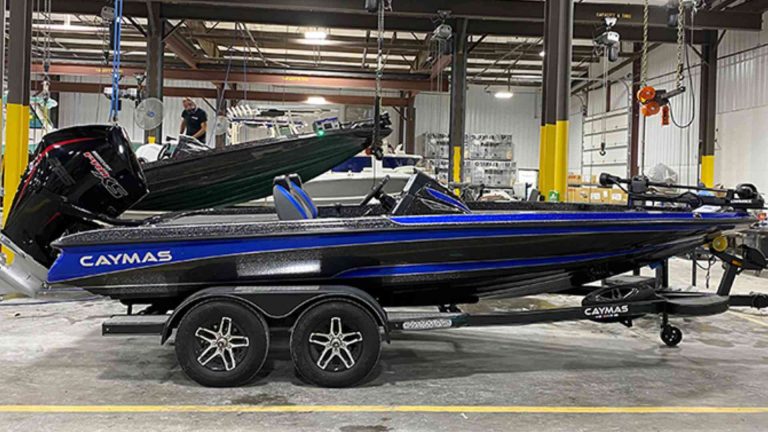
6 Caymas Bass Boat Problems
In the world of bass fishing, Caymas has risen to become a name synonymous with performance, innovation, and the pursuit of excellence. These boats have earned a dedicated following among anglers who demand the very best on the water. However, like any mechanical marvel, even Caymas bass boats are not immune to occasional challenges that…
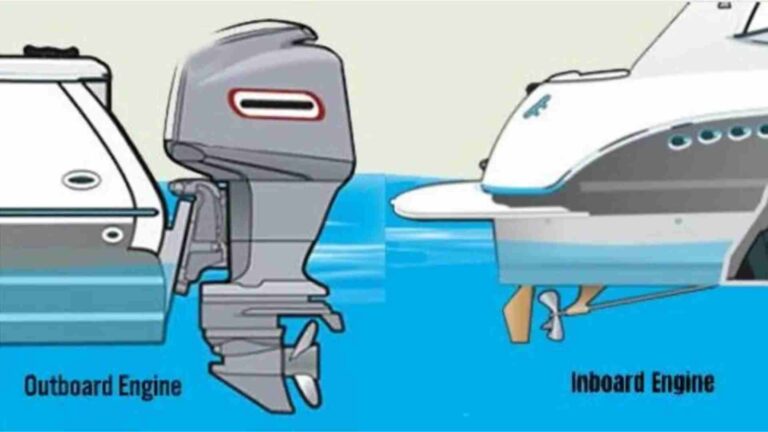
Symptoms to Detect Outboard is Mounted Too Low or Too High
Your trusty outboard roars to life, but something feels off. Your boat slogs through the water like a reluctant hippo, your steering wobbles like a jellyfish in a current, and you’re left wondering: is my outboard mounted too low or too high? Fear not, captains, for this guide will help you diagnose your engine’s woes…

8 Best Practices for Docking a Boat in Windy Conditions
Docking a boat can be a serene experience, a moment when the gentle lap of water against the hull welcomes you back to shore. Yet, when the wind whips up, that tranquil scene can transform into a heart-pounding challenge. The art of docking a boat in windy conditions is a formidable skill that separates novice…

5 Most Common Problems with Suzuki 350 Outboard
The Suzuki 350 outboard is a powerhouse engine, revered for its speed, fuel efficiency, and reliability. However, even the most robust machines can encounter issues, and the 350 is no exception. So, before you hit the throttle, let’s dive into the most common Suzuki 350 outboard problems and how to tackle them: 1. Water Intake…
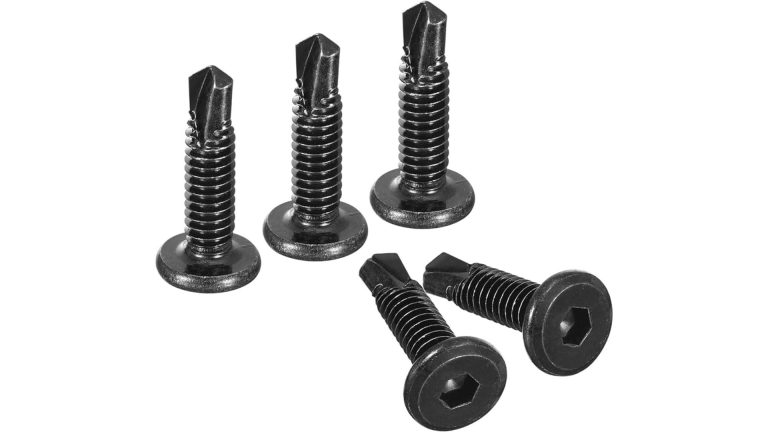
Can You Use Self-Tapping Screws on Aluminum?
Self-tapping screws are the unsung heroes of the fastener world, quietly revolutionizing how we work with aluminum and making countless DIY and industrial projects easier and more efficient. Their versatility and convenience make them indispensable when it comes to securing aluminum materials, from fabricating lightweight structures to repairing aluminum components. In this comprehensive guide, we’ll…
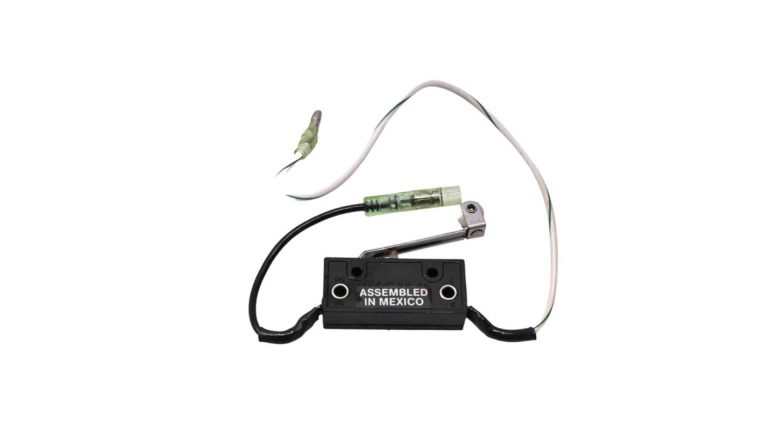
What Is Mercruiser Shift Interrupt Switch: How It Works?
In the world of boating, where the harmony between man and machine is essential, there exists a lesser-known yet vital component that ensures the seamless operation of boat engines: the Mercruiser shift interrupt switch. This unassuming yet indispensable device plays a pivotal role in boat engine systems, influencing performance, safety, and overall functionality. As we…
- Automotive Design Ideas
- Boat & Yacht Design
12 Fastest Speed Boats in The World in 2023
Fastest speed boat in the world – Spirit of Australia set the Guinness World Record for achieving a maximum speed on the water of 317.59 MPH. The boat is equipped with a 3000 hp Westinghouse J34 turbojet engine. But there are other incredibly fast boats – learn more about them in this article.

Since the appearance of the first boats equipped with an engine, the question has arisen – how fast can boats be? As a consequence, many people have expressed a desire to compete with their boats to find out which are the fastest. Since then, speed records on the water have skyrocketed.
In this article, we will not focus on the history of the development of speed boats and how speed records were set. Trust me, you could write a whole book about it. We will tell you about the fastest speed boats in the world in 2023, what characteristics they have and what top speeds have been achieved.
Secret of Fastest Boats
Modern speed boats have long crossed the speed limit of 200 MPH. How is it possible to achieve such incredible speeds on the water? The fact is that the density of water is higher than the density of air and the friction force that occurs between the hull of the boat and the water is a serious problem that engineers around the world are trying to solve.
For comparison, the fastest trains in the world achieve incredible speeds thanks to the magnetic cushion. Due to the absence of friction between wheels and rails. But the boat cannot be torn off the water, otherwise it will no longer be a boat but an airplane. The maximum that you can go for is special boats – hydroplanes.
For boats, the solution to achieving super speeds is easier than it sounds. These are jet and turbojet engines mounted on a strong hull that cuts through the water like a razor. The two fastest boats in the world, the Spirit of Australia and the Bluebird K7, have exactly this design. So it’s no surprise that the Guinness World Record for the fastest boat in the world is held by the jet-powered hydroplane Spirit of Australia which reached an estimated speed of 317.59 MPH.
Features of World’s Fastest Boats in 2023
12. outerlimits sv-52, max speed – 100 mph.
Outerlimits power boats are offering a wide range of speed power boats. Their faster boat category includes the SV-50, SV-52, SL-44, SL-52 and even catamarans like the 43CAT and 48CAT. The SV-52 is one of their fastest speed boats. It has been designed especially for superior high-speed performances and is known for its steady ride and soft landing even in rough and choppy waters.
The cockpit boasts of dual helm controls, a standard GPS chart plotter. They even offer both open as well as swim platform models. Most models also have a half cabin for easy storage of extra equipment or much-needed protection from the sun and the sea. At 52 feet, this long beauty is known to easily record 100 MPH plus speeds in even adverse conditions. It has a fuel capacity of 250 gallons and can easily accommodate up to four people in it.
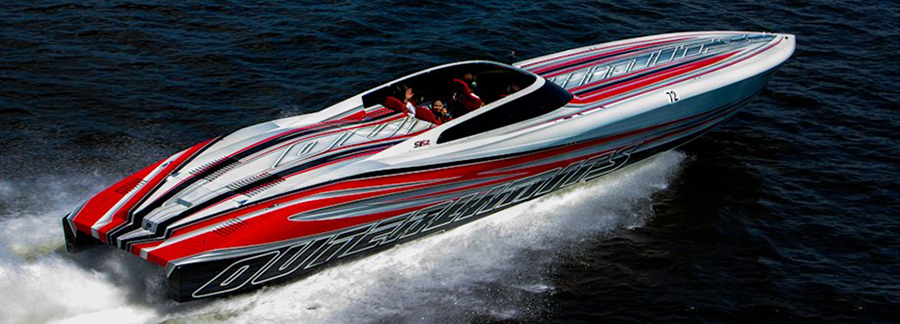
11. South Bay 925CR, max speed – 114 mph
The South Bay 925 CR is unbelievable the worlds’ fastest pontoon. If a pontoon can travel at speeds of more than 110 MPH, its only the South Bay 925 CR. In fact, when Brad Rowland’s South Bay 925 CR recorded a speed of 114 MPH, it was a new world record! It is fitted with superior Garmin GPS navigation. With a length of 27 feet and a beam of 8 feet, it is perfect for someone who doesn’t want a very large speed boat.
The standard equipment found on the South Bay 925CR are Manual Sport Arch, 4-speaker Bluetooth stereo, interior, and exterior LED light. If you are in the mood to create a perfect party ambiance you can even choose to opt for underwater LED lights.
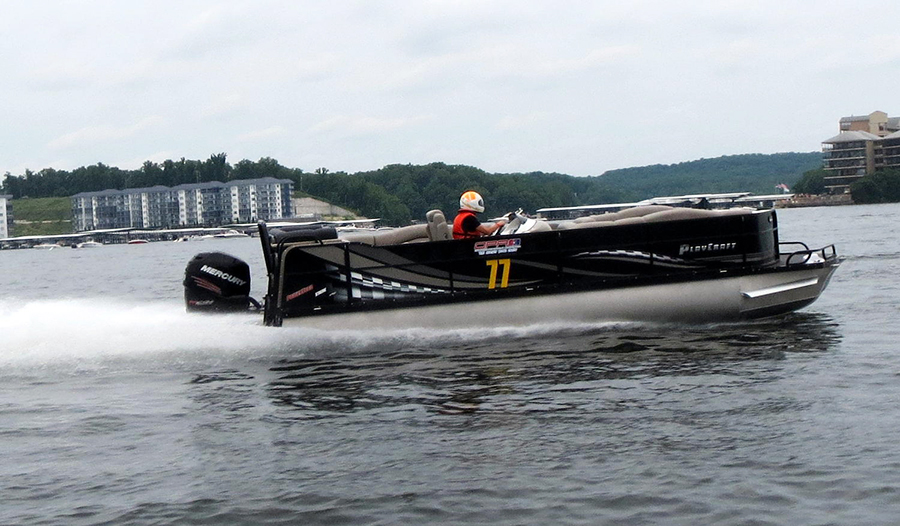
10. Fountain 47 Lightning, max speed – 115 mph
As the name suggests the Fountain 47 Lightning, is definitely lightning fast. The Fountain 47 Lightning is able to go as fast as 115 MPH. It’s decently sized at 47 feet and has a seating capacity of four to six people depending on the model you choose. It owes it’s super-fast speed to the twin Mercury Racing 1,075 HP engines. It is known as the cruiser boat that can go anyplace at any time.
The fuel tank capacity is 340 gallons and it also has a Fuel Vapour Detection system. The standard features on the Fountain 47 Lightning include a Garmin GPS, LED push-button switches on the navigation dashboard, and Vessel view instrumentation. The cockpit is equipped with LED cockpit lights, motorized hatches and bolster seats with electric drop-downmechanism. What more can you ask for?
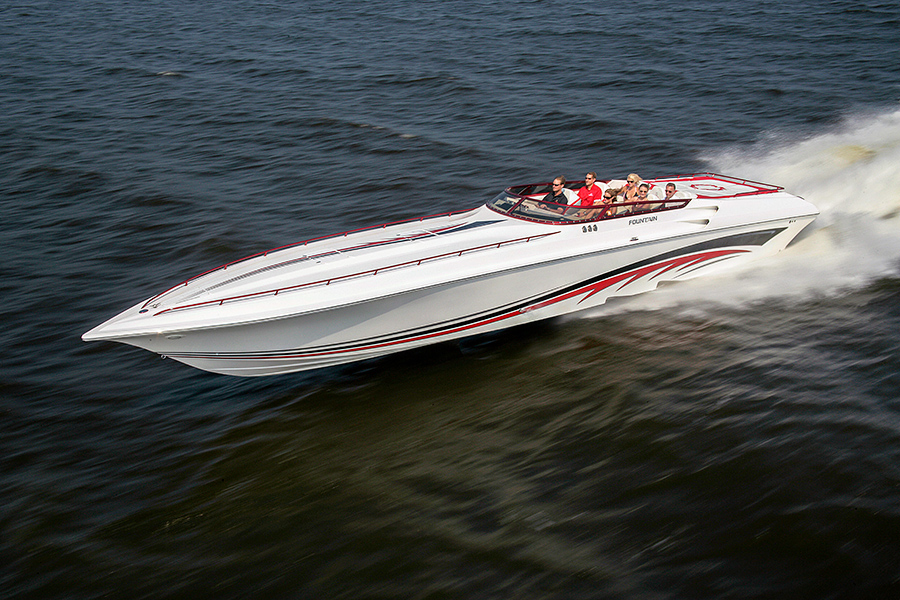
9. Cigarette Racing Team 50 AMG GTS, max speed – 135 mph
The cigarette racing team’s 50 AMG GTS slim and long cigarette shaped 50 AMG GTS is an incredibly powerful speedboat. It is considered to be one of the fastest electric speed boats in the world. It is powered by a 2200 HP AMG electric engine which also drives the SLS AMG Coupe Electric Drive – the world’s most powerful and fastest electric car. Check out 15 Fastest Cars in the World to find out just how fast cars can be.
This super fast electric speed boat is fitted with a lithium-ion battery containing 3,456 lithium-ion cells. The efficient battery pack can store power at 400 volts offering maximum driving current of about 6,000 amperes. This dashing speedboat has two chargers providing a total charging rate of 44 kW and just takes a meager seven hours for a full charge.
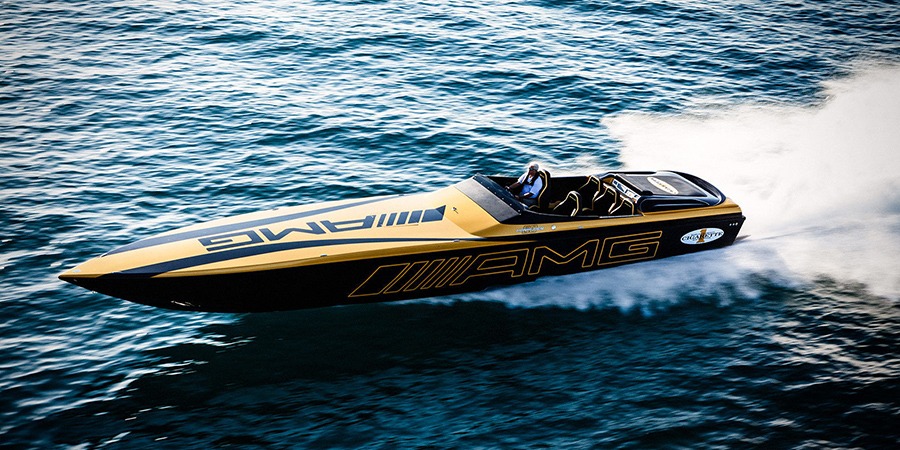
8. Nor-Tech 5200 Roadster, max speed – 150 mph
The Nor-Tech 5200 Roadster is a large boat with seating capacity for up to 10 people. Depending on the type of engine fitted, the 5200 Roadster can clock speeds of over 150 MPH. With a 400-gallon fuel tank, the 5200 Roadster has 5400 HP engines, making it one of the most powerful boats in the water. Along with offering unmatchable speeds, the Roadster is also the ultimate in luxury boating.
It features a padded sun lounge, swimming platform with boarding ladder and also video monitors. The Roadster is also equipped with a state-of-the-art music system and aft facing seats with coolers. Nor-Tech can also offer a wide range of configurations to suit our engine requirements.
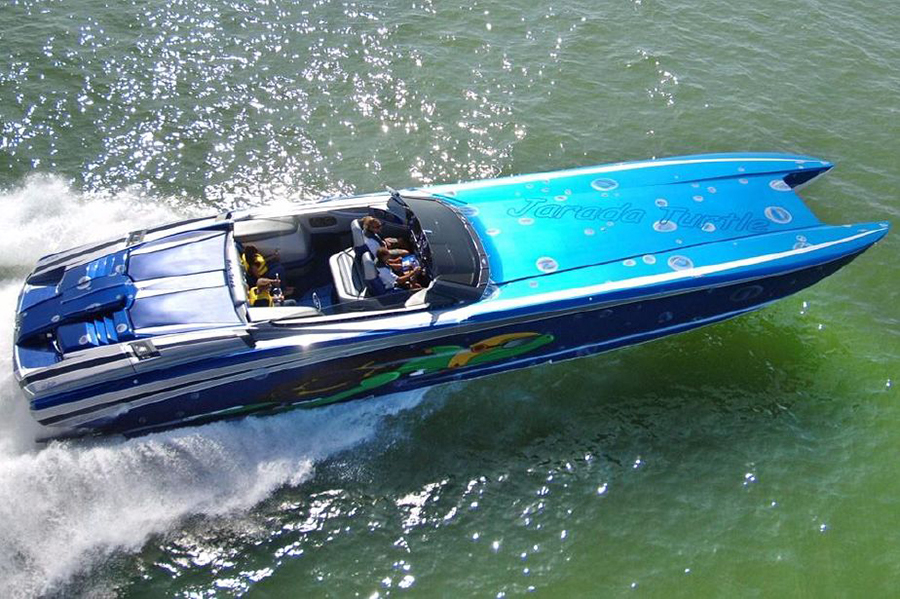
7. Skater 46 Pleasure, max speed – 175 mph
The Skater 46 Pleasure is a high speed and power boat. As believed by the company Skater, it is truly the “Rolls Royce of power boats.” The Skater 46 Pleasure is fitted with twin Teague Custom engines of 1500 HP each giving a total power of 3000 HP. The Skater comes with dual fuel tanks with a maximum capacity of 1,000 gallons. It is can easily cruise at more than 100 MPh for long hours and is designed for soft landings in rough waters.
With maximum speeds of approximately 175 MPH, the Skater 46 Pleasure is one of the fastest motor boats available today. Most boats also feature a complete stereo system and air-conditioning. Its spacious design can seat even five people. Its unique design lets you enjoy the speed thrill and also lets you sit back and enjoy the joy-ride.
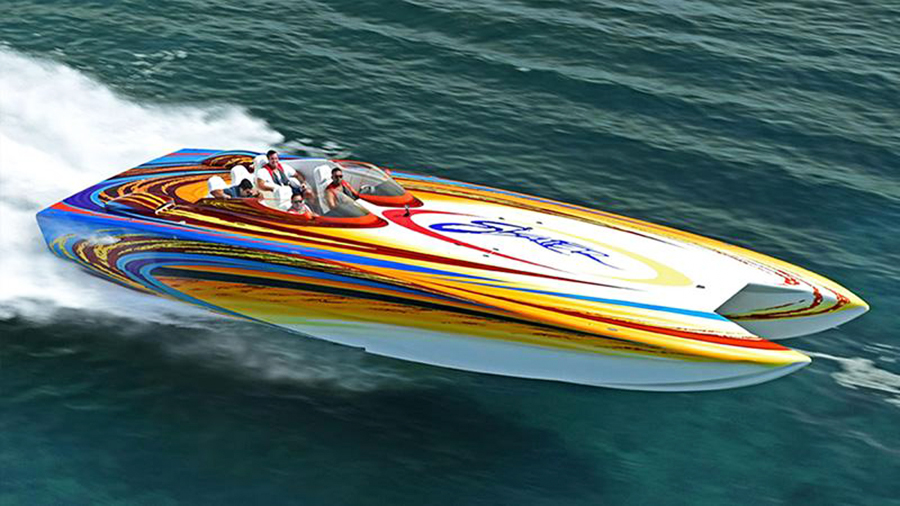
6. Lamborghini Aventador Super Veloce, max speed – 180 mph
Lamborghini’s Aventador Super Veloce is an incredible 52-ft, custom-built speedboat that runs on a 1550 hp engine and can reach up to an impressive 180 mph. Designed as a companion piece to the carmaker’s Aventador supercar, the boat is decked out in the same lime green (or ‘Verde Singh’) paint job.
The speedboat includes a cockpit that fits six people, outfitted with custom buttons and dials inspired by the car’s interiors, including a “Race” and “Pleasure” key that alternates between the boat’s top speed and a more relaxed pace. More information, photos and video you can find in our article about Lamborghini Aventador Super Veloce .
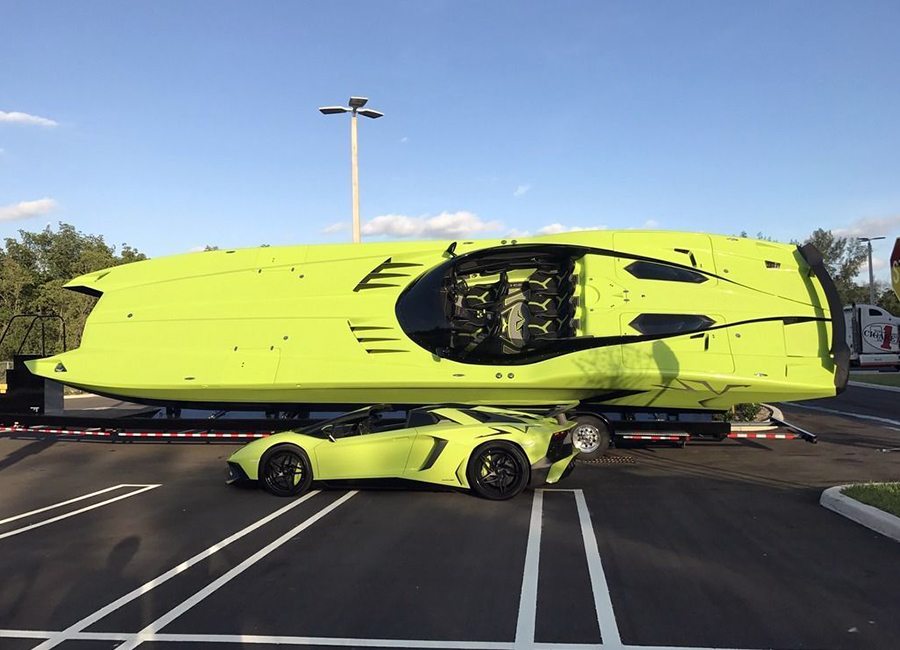
5. Spirit of Qatar, max speed – 244 mph
This is the fastest catamaran out there and fifth on the all-time speed list. The Spirit of Qatar uses twin Lycoming turbines to make a total of 9,000 Hp allowing this catamaran to reach ludicrous speed of 244 Mph (212 Knots). 50 feet long and full of turbine power, the Spirit of Qatar is a real eye catcher.
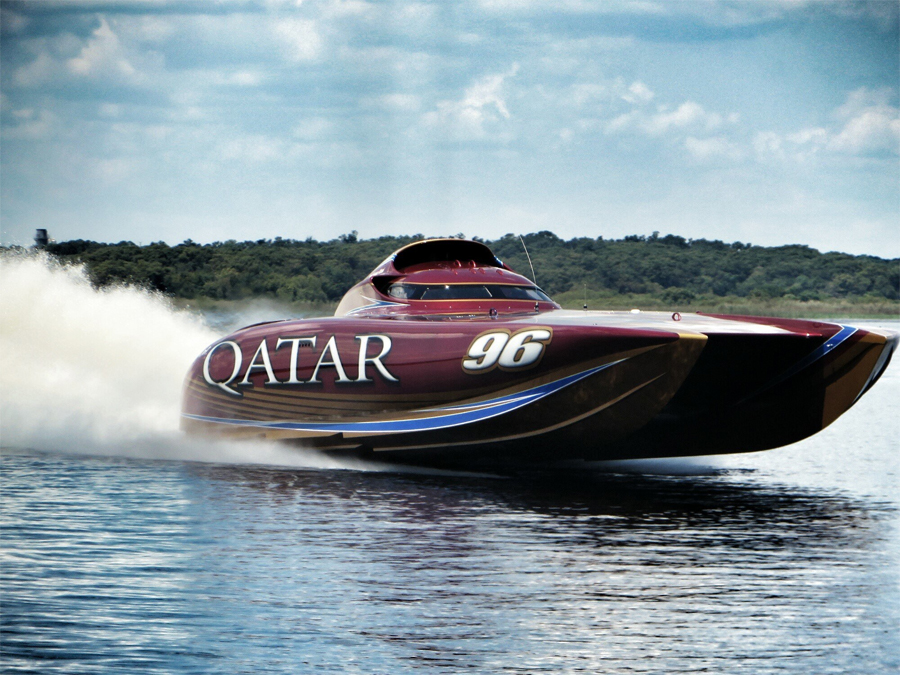
4. Mystic Powerboats C5000 Turbine, max speed – 250 mph
The Mystic Powerboats C5000 Turbine is manufactured by Florida based Mystic Powerboats. Powered by two 1850 HP engines it has a total engine power of 3700 HP and can easily reach cruising speeds of 150 MPH. The C5000 is considered to be one of the most powerful speedboats in the world today. The highest recorded speed of the C5000 is 250 MPH. The powerful C5000 beast runs on diesel. With a fuel tank capacity of 600 gallons, it has even recorded 15 engine hours.
The C5000 is almost 50 feet long. It comes equipped with electronic equipment like Log-speedometer, Plotter, Navigation center and GPS. Some of the extra features for enjoying your joy-ride are radio, CD player, and cockpit speakers. It also has a road trailer and launching trailer for ease of movement on land. This super-fast catamaran also offers cockpit air-conditioning. The Mystic Powerboats also offers C4400 and C3800 models.
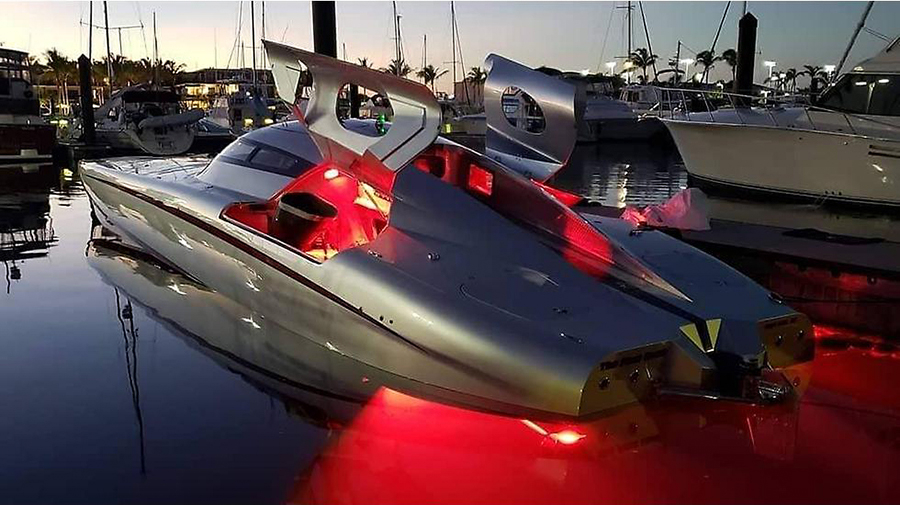
3. Problem Child, max speed – 262 mph
The Problem Child is the world’s fastest nitro drag boat. Ironically it gets its name due to its super-fast speed capacity. With a super-powerful 8000 HP engine Eddie Knox’s Problem Child is the fastest drag boat in the world. How fast can the fastest boat in the world run? It can reach speeds up to 262 MPH in just 3.5 seconds. Incredible, isn’t it? The Problem Child is the ultimate speed machine on water. This amazing speed monster literally seems to fly over water. With a speed crossing over 250 MPH, this incredibly fast drag boat is known to leave behind a wall of water as it speeds through it.
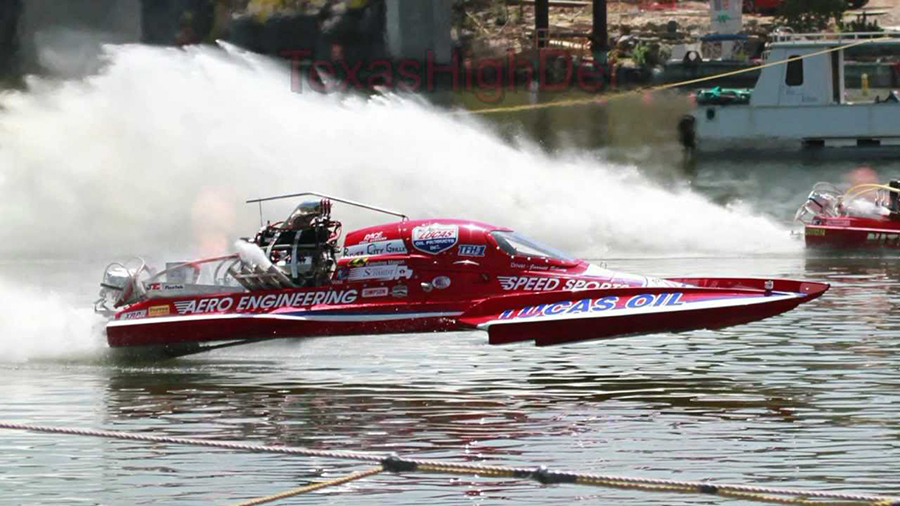
2. Bluebird K7, max speed – 276 mph
One of the oldest and fastest hydroplanes of the 20th century, the Bluebird K7 is considered to be one of the pioneers in the field of speedboats. Donald Campbell held the records of the fastest water speeds in the 1950s and 1960s in this amazing hydroplane. He set seven-speed records between July 1955 and December 1964. Unbelievably, the Bluebird K7 managed to record 276 MPH way back in 1964. Unfortunately, Campbell lost his life in 1967 while attempting to record a speed of 300 MPH. The wreckage of the Bluebird was recovered between October’2000 and May’2001. Campbell’s daughter has formally gifted the Bluebird’s recovered wreckage to the Ruskin Museum. It is believed that the Bluebird Project is undertaking trials for the return of Bluebird K7 to Scottish waters once again.
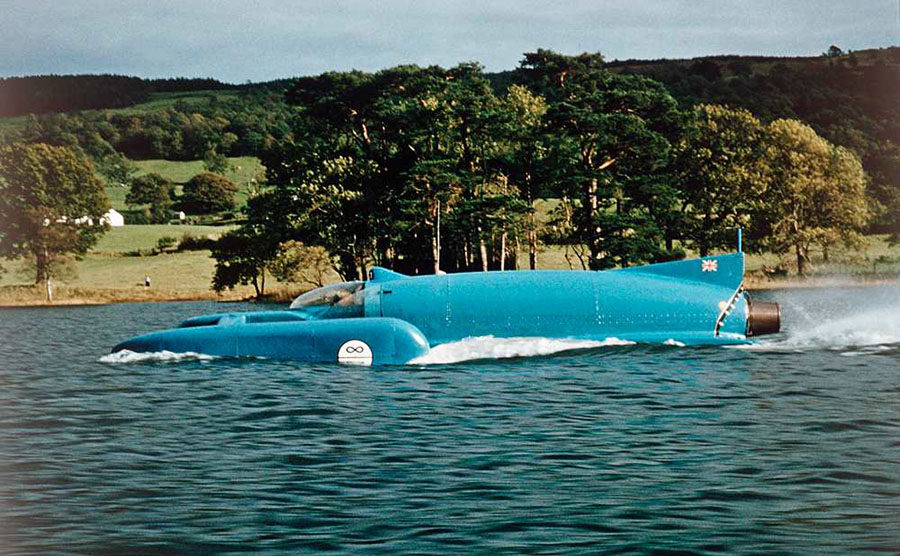
1. Spirit of Australia, max speed – 317 mph
Would you believe that the Spirit of Australia which holds the World Record of clocking a speed of 317.6 MPH in was designed and built by Ken Warby in his backyard? The wooden speed boat ran on Westinghouse J34 jet engines which are also used for aircraft and fighter jets. The Spirit of Australia is on permanent display at the Australian National Maritime Museum. Though several people have tried to break Warby’s world water speed record, none have succeeded. Warby also went on to build the Aussie Spirit as a successor to the Spirit of Australia.
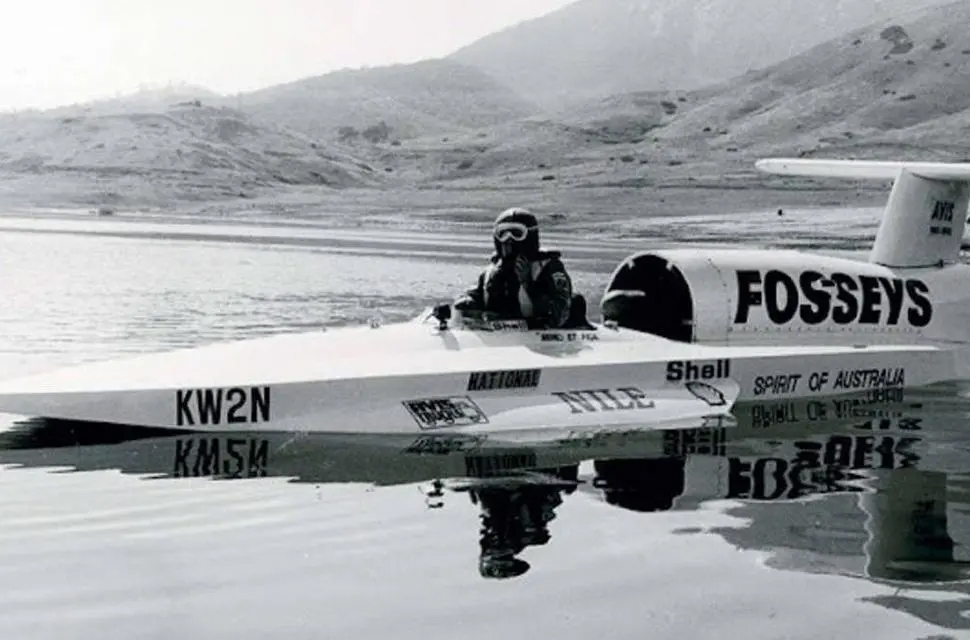
With so many awesome speed machines available, it is becoming increasingly easy to indulge in the ultimate adrenaline overdrive by sailing over waters. Cross the 100 MPH mark and enjoy the fastest boats in the world!
I ABSOUTELY LOVE, LOVE, LOVE THESE FRIGGIN HIGH SPEED BOAT DEMONS!!! I JUST CANT GET ENOUGH! KEEP IT COMING…….. MTI, DCB, DONZI, CIGARETTE,SKATER AMONG MANY MANY OTHERS! ROCK MY WORLD OF BOATS!! MY CHAPARRAL WILL DO BOUT 55. It’s a 24′ cuddy. I thought we were killin it. Well mines just as loud!! Hahaha Thanks for the vid. Peace………
I built a 72foot pontoon boat with a Volkswagen beetle 1300cc engine that did well over 300mph… On the salt flats outside our Vegas after a major rain. Do your research fools. Ours called the “turtle slug 1300+” crazy fast boat, especially on a lake!
There is an old Soviet ship called the Caspian Sea Monster that reached a max speed of 404 mph.
That was a plane,,,, it rode on Aa layer of air, not on water!!
There is an old soviet military ship (although it looks like a plane) that cruises at a speed of 220 to 340 mph and reached a max speed of 404 mph. It’s called the Caspian Sea Monster.
What about DCB?
Don’t forget the great Lee Taylor and Hustler. Held the record for 10 years between Blue bird and Spirit
Just letting you know that the images for #1 are actually of Spirit of Australia 2 (SoA2), not Spirit of Australia, the current record holder. SOA2 is a new boat made by the son of Ken Warby, who is aiming for 550km/h.
Y’all missed 2 boats. The Lamborghini aventador speed boat hits 180. And idk what the Corvette speedboat hit but it has 2700 hp.
Leave a Reply Cancel reply
Your email address will not be published. Required fields are marked *
You May Also Like
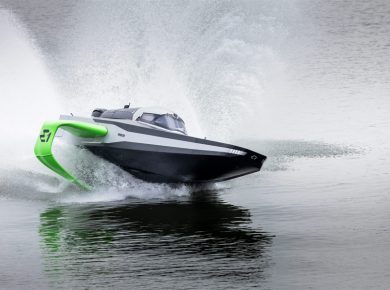
RaceBird Electric Powerboat
- Furniture Design
- Home Interior
- Car Interior
- Aircraft Interior
- Restaurant Interior
- Office Interior
- Shop Interior
- Modern Architecture
- Hotels Design
- Floating Houses
- Tiny Houses
- Tree Houses
- Luxury Homes
- Houses on Wheels
- Creative Photos
- Sculpture Art
- Fine Art Photography
- Art Inspiration
- Packaging Design
- Creative & Cool Products
- Music Products
- Modern Clocks
- Modern Lamps
- Most Expensive
- Inspiration
- Logo Design
- 3D Graphics
- Editorial Design
- Bike Design
- Aircraft Design
- Boat Design
- Train Design
- Modern Scooters
- Skateboards
- Accessories
SIGN UP FOR OUR NEWSLETTER
Subscribe To Our Newsletter And We Will Surprise You Each Week
- Bear's Books
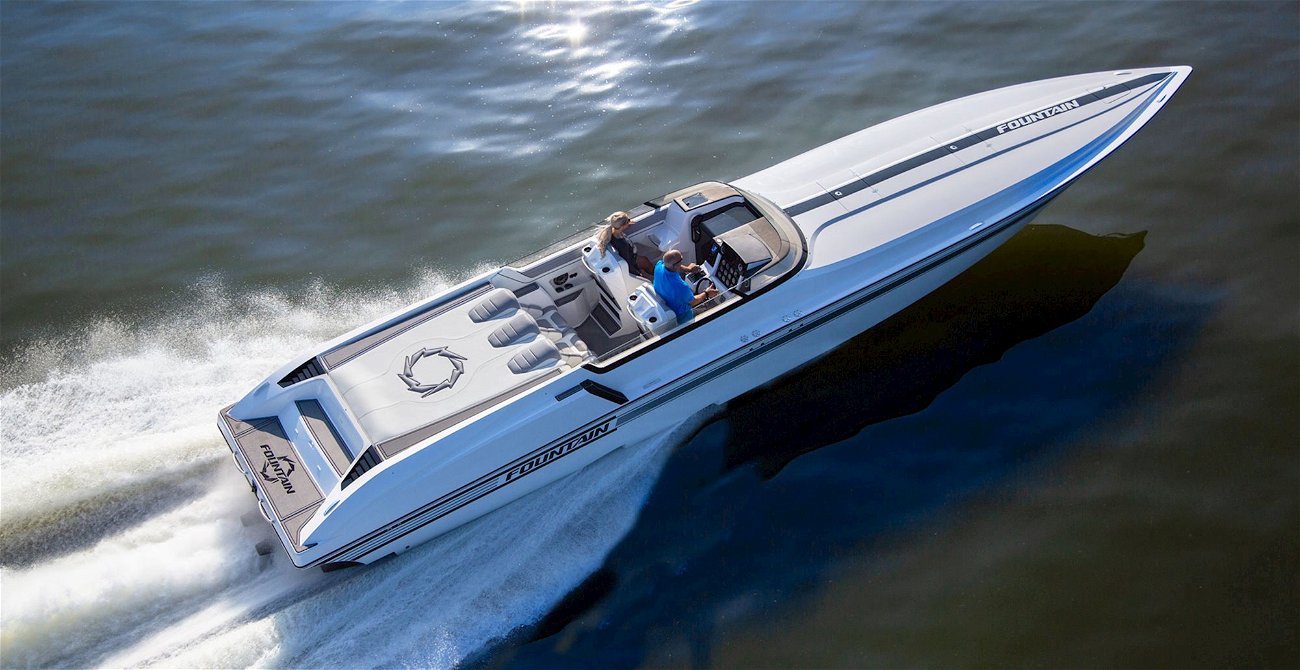
7 Fastest Speedboats of 2023
By Emily Duane
If you crave the adrenaline rush of high cruising speeds on the open water, a speedboat is the marine craft for you. According to a variety of boating authorities, the average top speed of a powerboat is 70 miles per hour (mph), with high-performance competition boats well into the 100s. The Guinness World Record holder for the fastest boat in the world is the jet-powered hydroplane Spirit of Australia, which reached an eye-watering speed of approximately 317 mph.
The speed-boat market offers multiple categories of boats designed to go fast, including V-bottom, catamaran and center-console body styles . They’re equipped with two to four motors—inboard or outboard—to provide all that power that pushes the limits on the water.
To find the best new powerboat for you, do some research and compare the specs and features of different brands and models, understanding that different engine packages and other add-ons affect the price. To start you off, here’s a list of the fastest speed boats on the market for 2023.
1. Nor-Tech 390 Sport
The 390 Sport from Nor-Tech easily lets you flirt with 80-mph speeds. This center-console boat offers stability on the water and is comfortable for everything from speedy rides to fishing and diving. The 390 Sport comes with triple or quad Mercury motors. Enthusiasts have topped 100 mph powered by quad Mercury Racing Verado 400R outboards on jack plates.
Style: Center console
Price: Starting at $700,000
Length: 39 feet
Beam: 10 feet
Weight: 12,500 pounds
Top speed: ~80 mph
Nor-Tech 390 Sport Full Specs
2. Baja Marine 36 Outlaw
To achieve high speeds without fully liquefying your insides, Baja Marine’s 36 Outlaw is an excellent option. Whether you’re taking your chances at a poker run , cruising to sand bars or treating friends to wild tubing rides, the Outlaw is here for it. Enthusiasts have hit top speeds of around 84 mph with Mercury Racing 565 engines.
Style: V-bottom
Price: Starting at $307,000
Length: 37 feet, 1 inch
Beam: 8 feet, 6 inches
Weight: 9,300 pounds
Top speed: ~84 mph
Baja Marine 36 Outlaw Full Specs
3. Mystic C4000
The dual-hull Mystic C4000 balances comfort and speed, offering a day of adventure on the water that can effortlessly go from leisurely to thrilling in seconds. Enthusiasts claim this boat is something straight out of a James Bond movie. Easy to drive and powered by just two outboard engines, the C4000 can top 100 mph, making it a shoo-in for offshore racing.
Style: Catamaran
Price: Starting at $785,000
Length: 43 feet, 10 inches
Beam: 10 feet, 11 inches
Weight: 6,800 pounds
Top speed: ~120 mph
Mystic Powerboats C4000 Full Specs
4. Donzi Marine 38 ZRC
Fast, fun and attractive, the Donzi Marine 38 ZRC experienced a revival in 2020 with its unique fighter jet windscreens and a V-bottom hull designed for speed. Buyers can choose between Mercury Racing 565 HP Bravos or staggered 860s with #6 drives to power this model. Enthusiasts have reported exceeding 120 mph in this powerboat.
Price: Starting at $560,000
Length: 38 feet, 1 inch
Beam: 8 feet, 1 inch
Weight: 11,500 pounds
Donzi Marine 38 ZRC Full Specs
5. Outerlimits SV-50
If you’re looking for the marine equivalent of a race car, the Outerlimits SV-50 is the ticket. This sleek and luxurious powerboat has room for up to five passengers and is designed for speedy thrills on the open water. Powered with Mercury Racing 1350/1100 engines, the SV-50 hit a top speed of 145 mph during a test ride in early 2023 on a mid-30-degree day in Rhode Island’s Narragansett Bay.
Price: Starting at $1.5 million
Length: 50 feet, 1 inch
Beam: 9 feet
Weight: 10,900 pounds
Top speed: ~145 mph
Outerlimits SV-50 Full Specs
6. Fountain Powerboats 42 Lightning
If you’re looking for a powerboat that offers a smooth yet forceful push to top speeds and a comfortable and stable ride once you’re there, you’ll get it in Fountain’s 42 Lightning. It goes from 0 to 30 mph in 9.5 seconds, and the only limit to top speeds is your nerve—this boat can hit 160 mph with 1,350/1,550 packages.
Price: Starting at $685,000
Length: 42 feet
Beam: 8 feet, 4 inches
Weight: 13,400 pounds
Top speed: 160+ mph
Fountain Powerboats 42 Lightning Full Specs
7. Eliminator 28 Speedster
With a name that includes the words “eliminator” and “speedster,” it should be no surprise that this catamaran zips to the top of this list with max speeds of 170 mph. Available with inboard and outboard options and a variety of deck and bow configurations, the Eliminator 28 Speedster can be customized for however you want to spend your time on the water.
Price: Starting at $300,000
Length: 28 feet, 10 inches
Weight: 4,000 pounds
Top speed: ~170 mph
Eliminator 28 Speedster Full Specs

8-Year-Old Boy Plans to Climb to Everest Base Camp for Charity
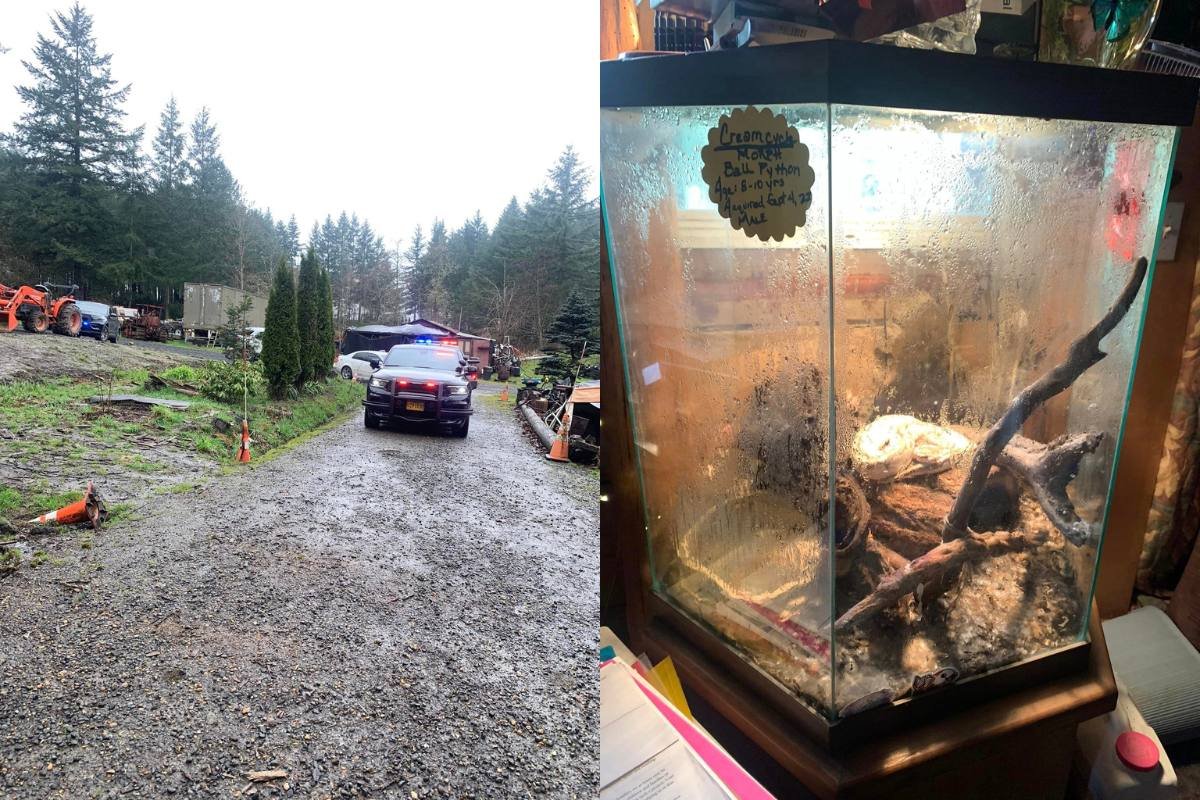
Oregon Resident Accused of Freezing Puppies to Feed Them to Pet Snakes
Leave a comment cancel reply.
Your email address will not be published. Required fields are marked *
Save my name, email, and website in this browser for the next time I comment.
Register for newsletter (optional)
More Like This

Hiking Shoes Under $200 for Your Next Mountain Adventure

The Best U.S. Colleges and Universities for Outdoor Lovers

NEWS: Alien-Like Ratfish Caught in Norway

Fall Camping in Tennessee’s South Cumberland State Park at Foster Falls Campground

8 of the Best Places to Paddleboard in Fall

Zippo Outdoor Emergency Fire Starter
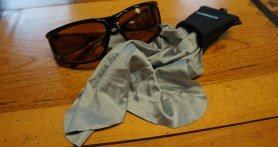
Alpine Innovations Spudz, Keeping Your Lenses Clean!
Review of zippo rechargeable lithium ion hand warmer – good stuff, more stories.

Boating Basics Online is reader-supported. When you buy via our links, we may earn a commission at no cost to you. Learn more
How Fast Do Speed Boats Go? – Updated in 2023
Written by J. Harvey / Fact checked by S. Numbers
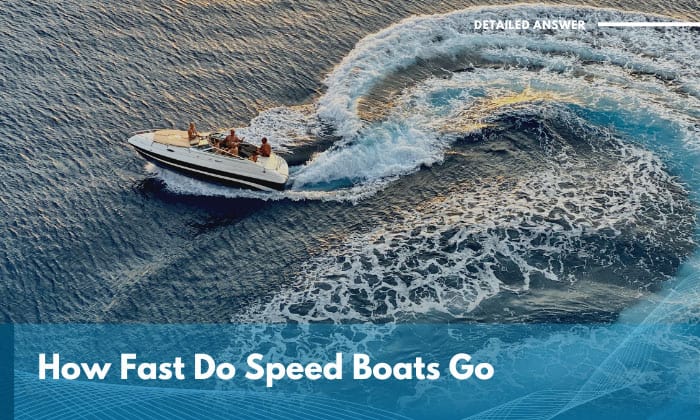
When people ask me, “How fast do speed boats go?”, I often resist the urge to just give them a general figure. Still, there are quite a handful of different types of speed boats already so to say that 50 mph won’t do them justice.
If we’re going to look at the average speed of most “regular” speed boats that figure is, in fact, the minimum. Plenty can achieve 70 mph .
More specialized speed boats can achieve 3x or 4x that in top speed, though. The three quickest in the world have a range of 261 to 317 mph .
Table of Contents
Different Types of Boats and Their Speed Averages
Average and maximum speed of performance-based boats, how to calculate speed, comparison table of casual, fishing, and top racing speed boats, factors affecting the speed of speed boats, frequently asked questions.
It’s worth noting the various average speeds of the main types of boats in mph or km/h, so you can easily compare speed boats to other vessels. I’ve compiled them all here for your easy reference with mph as the main metric:
- A V-hull or a boat with a planing hull runs at 47 mph.
- A center console achieves 65 mph.
- An average sailboat or yacht can go for 8 mph, but racing varieties can manage close to double that.
- A pontoon boat rests somewhere around 30 mph.
- A kayak moves at 3 mph.
- A houseboat, regardless of size, cruises at 11.5 mph.
As you can see, it’s difficult to pinpoint the exact average speed of a boat, considering the general nature of that question. What kind of vessel are we talking about exactly?
You have to be more precise like, “What is the average speed of outboard speed boats?” or “What is the typical speed boat max speed?” All the while, you also have to account for the different manufacturers and how they design their vessels, which can have a bearing on speed.
Get all the complete, verifiable answers to these questions in the next section.
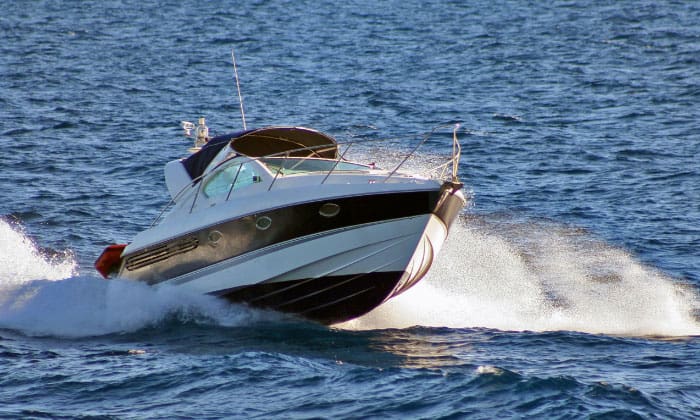
In most cases, speed boat top speed also factors in power boats. That’s all well and good since they’re generally accepted as synonymous with each other.
I’ve already mentioned the average speed above. The maximum speed of speed boats as a whole is 100 mph.
But does that ring true for all brands? Let’s find out by checking out their performance in calm waters.
- A standard Cigarette boat can run at 92 mph.
- Go Fast boats, notoriously preferred by smugglers, can achieve the same
- Apache speed boats reach 100 mph, although they’re categorized as racing boats.
- Nor-Tech sport boats hover at around 80 mph. Their catamarans have a top speed of over 200 mph, though.
- Most recent Outlerlimits boats nowadays can break the 100-mph limit.
As you can see, a closer inspection of the most well-recognized already gives us both slightly and vastly different figures. What more if we include every speed boat and power boat manufacturer in the picture?
There’s no use doing that, though, the ones mentioned above, more or less, already serve as a reliable sample group.
Is 50 mph fast for a boat? Yes, but if we’re going to compare these “normal” vessels to the best racing boats top speed, they’re quickly overtaken.
For example, the Spirit of Australia, which was built way back in 1978, still holds the title of fastest boat in the world. No other vessel in existence has beaten its top speed of a whopping 317 mph.
If there ever was a competition crowing the fastest small boat, it will undoubtedly earn that title with quick ease.
The Bluebird K7 and the Problem Child come at a not-so-close second and third with top speeds of 276 mph and 262 mph, respectively.
If you’ve always wondered, “How fast do racing boats go?” take all of the brands and unique boats we featured here to get a crystal-clear idea.
There are two ways I normally go about this. The easiest route for me is to just rely on the onboard speedometer. If it’s in knots and you prefer to get it in mph, just multiply the figure by 1.151.
If you want to get technical and double-check, you can start by measuring the distance traveled in a specific amount of time. Measure in meters per second first.
Then, divide that distance by the time that elapsed to cover it. For example, 77 meters divided by 7 seconds = 11 meters per second.
11 m/s = 24.6 mph
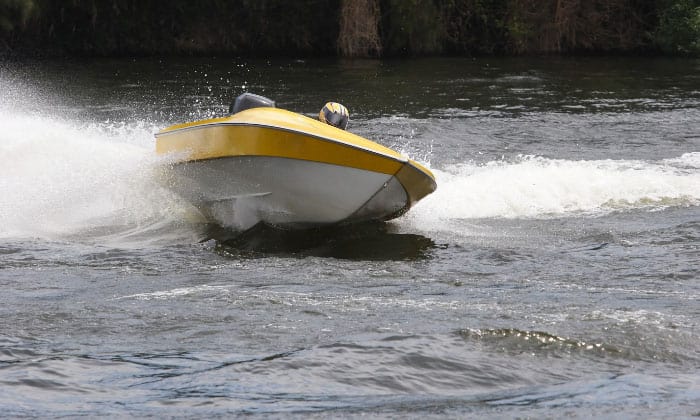
- Boat’s length – Longer boats tend to go faster thanks to their greater waterline length.
- Hull design – Semi-displacement hulls tend to be faster than displacement hulls, while it’s difficult to match the top speed of planing hulls at relatively higher speeds. At best, it’s all thanks to their ability to raise a portion of the bow (i.e. planning) that decreases drag.
The same rings true for V-shaped hulls.
- Engine and propellers – Naturally, a powerful engine propels a boat faster compared to weaker varieties. Short-pitched propellers take the load off the engine as well.
- Wind and water conditions – If you’re going opposite the current, waves, and wind, expect your speed to be halved or cut even more drasticall Of course, you can expect the reverse if they’re working in your favor.
- Water depth – Shallower water typically decreases a boat’s speed and may even pose a great risk to the propellers. In deeper waters, it’s the exact opposite as they can work optimally.
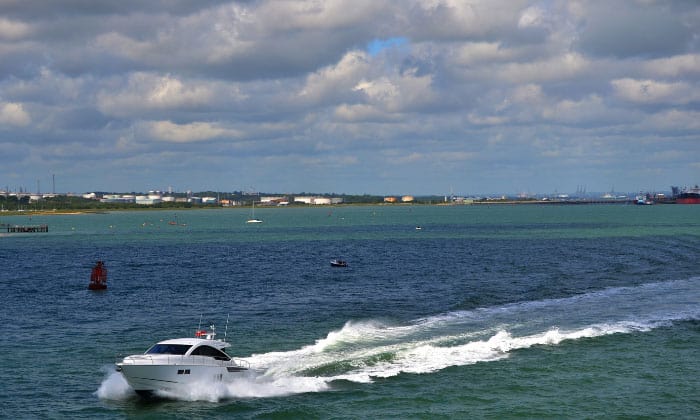
Tips to get involved in high-performance boating
Go slow first and don’t rush to higher speeds until you’re ready. Ideally, you need to increase speeds gradually until you get the hang of them.
Find time to master your steering. I also can’t stress enough the importance of learning how to plane your boat and avoiding porpoising.
This takes practice session after practice session. If you want a visual tutorial to get you started, here’s one that helped me a lot:
Finally, get to know your vessel more, particularly its limitations.
Tips to learn to drive (and safely handle) a go-fast boat
I only have one answer to this: Always take the time to get the right training through official courses. Doing so already allows you to tick important checkboxes like safety, handling, trimming, docking, and other essentials.
This isn’t really something that you can rush, especially as past trends have shown that most people struggle with simple maneuvering and docking/parking.
Have my inputs given you a clear and complete answer to the main question, “How fast do speed boats go?” To sum up how we arrived at the figures:
- I looked at the average and top speeds of most of the popular speed boat brands.
- I shared the three fastest production boats above, which are unlikely to be topped by any mass-produced boat any time soon.
- I outlined the possible factors that may affect speed.
- I also shared guidelines on how to effectively handle certain types of speed boats.

“My intention from the first day establishing Boating Basics Online is to provide as much help as possible for boaters who want to experience a first safe and convenient trip. So feel free to join us and share your beautiful journeys to the sea!”
Welcome to Lake
Discover places to stay and unique experiences around the world.
- How It Works
Home - Blog - Powerboats 101: The Ultimate Guide to Speed and Thrills on The Water
Powerboats 101: The Ultimate Guide to Speed and Thrills on The Water

David Ciccarelli
February 2, 2024
In this article
Get started.

Types of Powerboats
When you’re out on the water, the kind of powerboat you choose can greatly influence your experience. Whether it’s for leisure or sport, these mechanical marvels are as varied in design and functionality as they are exciting.
If you’re all about velocity and performance, you’ll find speedboats produce an adrenaline rush that’s hard to match. Known for their powerful engines and sleek design, these boats are built for speed. Imagine feeling the wind whip through your hair as a twin-engine speedboat races across the water’s surface.
Ready for a fun-filled day with family and friends? Then the versatile bowrider is your go-to. With open bow areas, these boats welcome more passengers and facilitate a variety of water activities.
Cabin Cruisers
Experience luxury on the water with a cabin cruiser. These boats often include comfortable accommodations—think of them as your floating holiday home. With amenities for overnight stays, they cater to the cruiser who doesn’t want to leave the comforts of home behind. Cabin cruisers typically use robust inboard engines and technology to offer a smooth, steady ride for those long-distance ventures, as described by luxury boat manufacturer, Ocean Yachts.
Center Console Boats
Whether you’re an avid fisherman or enjoy casual trips around the bay, center console boats have become synonymous with versatility. With the helm positioned in the center of the boat, you get 360-degree access to the water, perfect for casting a line from any angle. Many center consoles are rigged with triple outboard engines, giving a reliable performance.
Key Features and Accessories
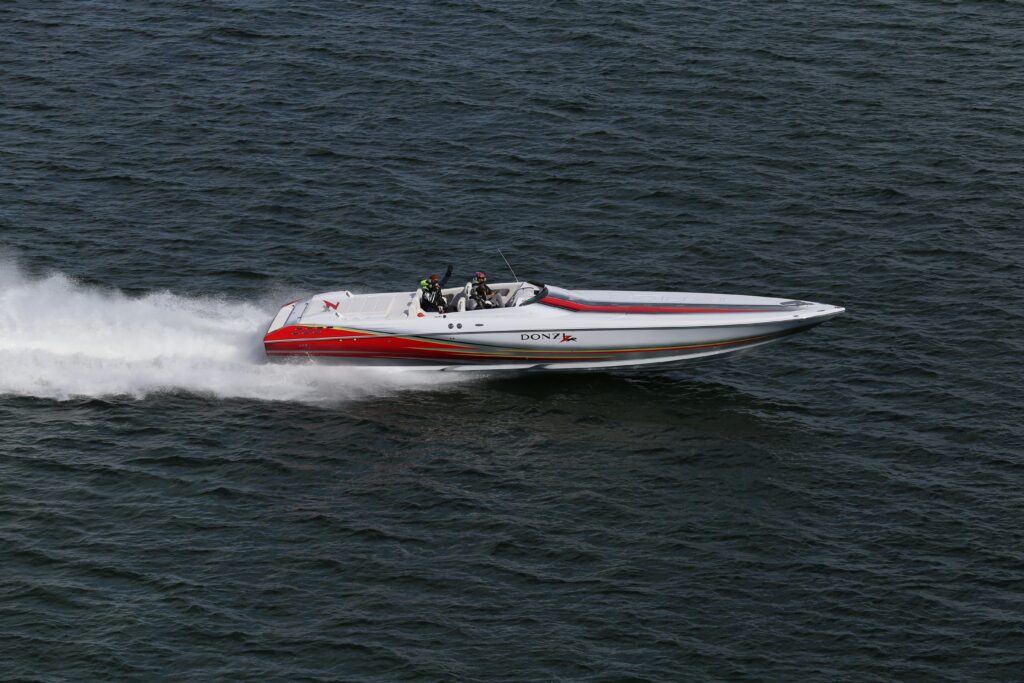
In the exhilarating world of powerboats, every enthusiast knows that it’s the advanced engines, sleek hull designs, cutting-edge navigation systems, and luxurious touches that distinguish the best vessels. Whether you’re out for performance or indulgence, let’s explore what sets a premium powerboat apart from the rest.
Engines and Horsepower
Have you ever felt the thrill of raw power as you throttle up? The heart of a powerboat is its engine, with horsepower (HP) ratings that can soar into the thousands for performance models. For instance, Formula Boats, known for their high-performance powerboats , equip their vessels with engines that can deliver upwards of 600 HP. High-powered engines ensure that propulsion and performance are maximized for those who crave speed and agility on the water.
Hull Design
Ever wondered why a powerboat cuts through the water like a knife through butter? Hull design is key , with deep-V designs commonly used for their ability to slice through waves and provide a smoother ride in rough conditions. The design isn’t just about performance; it significantly contributes to the vessel’s safety and stability.
Navigation and Electronics
Today’s powerboats are akin to technological marvels floating on water. The integration of high-tech navigation and electronics systems is essential for both safety and convenience. Touchscreen interfaces, GPS mapping, and radar can be found on state-of-the-art models, with technology like the Simrad GO9 XSE being an example of a top-tier fish finder with navigational competencies.
Comfort and Luxury
Lastly, who says you can’t be comfortable while zipping across the waves? Powerboats can be floating paradises with luxury and comfort rivaling high-end automobiles. Premium seating, ample storage, and amenities like air conditioning and heaters mean that your time of the water is as enjoyable as possible. For those who appreciate the finer things, accessory options such as the best boat grill from Magma or waterproof Bluetooth speakers enhance the experience—think concert hall acoustics at the mere push of a button.
Don’t you agree that knowing the ins and outs of these features will not only boost your boating knowledge but also influence your next purchase or upgrade? After all, it’s these details that can define your seafaring lifestyle!
Powerboat Brands and Manufacturers
When you’re exploring the world of speed and luxury on water, you’ll come across some standout names synonymous with quality and reliability. Let’s steer our course through some of the leading powerboat brands known for their exceptional performance boats, comfort, and style.
Yamaha Boats
Yamaha stands as a titan in the marine industry, offering a fleet of powerboats that blend performance and pleasure. With their jet propulsion systems, these boats are not only fun but also safe, as they come without external propellers. The Yamaha lineup includes models ranging from nimble jet boats to spacious luxury versions, where you can feel the thrill of the waves without compromising comfort.
Considered by many as a leader in the powerboat realm, Sea Ray crafts vessels that epitomize the balance between elegance and edge. Known for their sporty yachts and cruisers, Sea Ray’s models offer you a slice of heaven with their plush interiors and state-of-the-art amenities. It’s not just about the looks; these boats are engineered to perform, ensuring your time on the water is nothing short of extraordinary.
Boston Whaler
Praised for their unsinkable hulls, Boston Whaler has carved a niche for themselves in the powerboating world. This manufacturer is particular about safety and dependability without skimping on luxury. Their boats, often termed the “Legends of the Sea,” range from versatile center consoles to upscale cabin cruisers, giving you a trusted platform for any aquatic adventure.
Uncover the passion behind each model’s creation and set sail on your next voyage with a trusted builder. Whether you’re after adrenaline-filled water sports or serene yachting escapades, these brands have something tailored just for your experiences on the water.
Choosing the Right Powerboat

When you’re in the market for a powerboat, the sheer variety can be overwhelming. You want performance, luxury, and technology, all within your budget. Let’s slice through the waves and focus on what really matters for you and your nautical adventures.
Assessing Your Needs
What are you dreaming of when you think of a powerboat? Is it speeding across the bay, rods bending with the next big catch, or leisurely cruising with your family? Identify the primary use: fishing , family fun, or traveling long distances. Keep in mind, the choice you make here steers the rest of your decision-making process.
Budget Considerations
Be frank about your budget. A brand new speedboat can set you back a hefty sum, but remember, the initial price isn’t the whole story. The National Marine Manufacturers Association states that maintenance costs can be about 10% of the purchase price annually, so factor that in when you’re thrashing out the numbers.
Size and Maneuverability
Bigger isn’t always better. A compact powerboat can offer thrilling performance and easier handling , particularly in choppy waters. Conversely, a larger vessel may be necessary for stability and features when planning long-haul sea journeys. Consider what you’ll be comfortable maneuvering and where you’ll be doing most of your boating .
New vs. Used Boats
A shiny, new boat is tempting, but a gently used vessel could get you more bang for your buck. When considering new versus used, weigh the warranties and the potential for modern features against the depreciation and potential hidden costs of pre-owned models.
Maintenance and Care
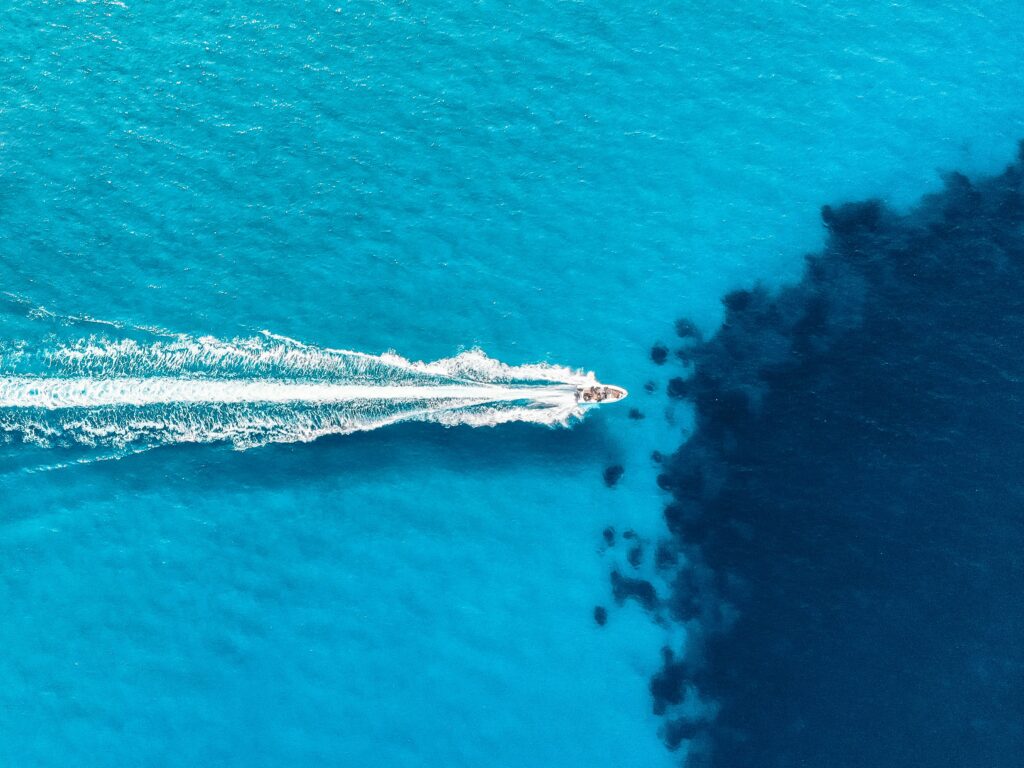
Taking care of your powerboat is crucial to ensuring peak performance, maximizing reliability, and guaranteeing safety during your watery adventures. Remember, a well-maintained powerboat can save you money in the long run on costly repairs and downtime.
Regular Maintenance
The heartbeat of your powerboat is its engine, and routine maintenance is your best defense against unexpected failures.
- Check the fuel tank : Always start with inspecting the fuel tank for any signs of contamination or leaks, as clean fuel is essential for a healthy engine. Did you know that water contamination in the fuel accounts for a significant percentage of marine engine issues ?
- Engine checks : Regular oil changes and filter replacements are like a health check-up for your powerboat, and adhering to the manufacturer’s schedule can also preserve the warranty.
- Battery care : Keep the battery terminals clean and check the charge before setting sail. A dead battery is a common headache you’d rather avoid.
Remember, each manufacturer has specific guidelines , so consult your owner’s manual for detailed instructions!
Cleaning and Storage
A clean powerboat isn’t just about good looks—it’s about ensuring longevity and maintaining value.
- After each outing , rinse your powerboat to remove salt, algae, and other abrasive materials. Boats.com suggests using a light brush and mild soap for most cleaning tasks.
- Storage tips : When it’s time to dock for longer periods, proper storage conditions are essential to keep your powerboat safe from environmental damage. Keep it covered and, if possible, out of the water to prevent hull blisters and corrosion. Remember, a well-protected boat ensures that the safety measures you rely on are always in order.
Ultimately, maintaining and caring for your powerboat is a journey, not a destination. It’s about keeping you, your passengers, and your investment safe. So, grab your mild soap and maintenance checklist, roll up your sleeves and give your powerboat the love it deserves!
Safety and Regulations
When you set out on your powerboat, it’s crucial to keep a few things in mind: your safety, the safety of your passengers, and staying compliant with rules and regulations. Let’s not skim over these details, as they could mean the difference between a fantastic day on the water and an unpleasant run-in with the authorities—or worse, an accident.
Powerboat Safety Essentials
Before throttling up your speed machine, let’s talk about what you should have on board to ensure everyone’s safety. Don’t forget, this isn’t just good sense—it’s the law.
- Life Jackets : First and foremost, you need a USCG-approved life jacket for each person aboard. They aren’t just floaty fashion statements; they save lives.
- Communication Device : An efficient sound-producing device is mandatory for powerboats less than 65.6 feet. In simple terms, make sure you have a way to signal for help if the unexpected occurs.
- Fire Extinguishers : Fires can happen, even on water! Ensure you have the right type of fire extinguisher on board to handle any flames that dare disturb your peaceful voyage.
- Navigation Lights : If you’re out past sunset or before sunrise, proper lighting is not optional. It’s about seeing and being seen.
Boating Regulations
Regulations are like the buoys of boating—they guide you safely and keep you in line. What do you need to know to stay legal and enjoy your time without hassle?
- Licensing : Depending on your location, you may need a boater’s license . Think of it as a driver’s license for the water. Make sure yours is current and recognized by the waters you’ll be cruising.
- Speed Limits : Yes, they exist on the water too! Not every area is a free-for-all. Certain zones will have restrictions especially near marinas, swimming areas, or ecologically sensitive regions.
- Comfort : We’re not just talking plush seating—a comfortable outing also means having enough space for each passenger and not overloading your boat beyond what’s considered safe capacity.
- State-Specific Regulations : You’ve got your federal laws , and then you’ve got your state quirks. Some states have specific rules that are unique to their waters, so do your homework!
Remember, each powerboat is a unique vessel and recommends it’s own maintenance rituals that can affect your safety and adherence to regulations. Brand names like Sea Ray and Boston Whaler are known for crafting their boats with safety and comfort in mind.
By taking the time to familiarize yourself with these safety measures and regulations, you’re not just preparing for a safe trip; you’re ensuring that your time on the water is as enjoyable and stress-free as possible. Now, who’s ready to make some waves, within limits, of course?
FAQs (Frequently Asked Questions)
What speeds can I expect from a powerboat? Your powerboat’s speed can vary widely based on factors like size, design, and engine power. Generally, a leisure powerboat might cruise around 20 knots, while high-performance models could soar past 50 knots!
Any safety tips for first-time powerboat users? Absolutely! Always wear a life jacket, check the weather before heading out, and ensure your boat has all necessary safety equipment. Familiarize yourself with the operation and emergency procedures—safety first!
Is fishing viable with any powerboat? While not all powerboats are designed for fishing, many are very suitable. Features like rod holders and live wells turn a standard powerboat into a fishing-friendly vessel.
Remember, the joy of boating comes with responsibility. By keeping these FAQs in mind, you’re all set for a fantastic time on the water. Happy boating!

administrator
David Ciccarelli, is the Founder and CEO of Lake. He is based in Toronto, Canada, and is an expert in management, business administration, strategy, product development, and customer experience. His educational achievements include the Owner President Management Program at Harvard Business School (2019-2022) and the QuantumShift Program at Ivey Business School in 2017, aimed at CEOs of growing businesses.
Related Posts

October 3, 2023
Boating: Your 10-Step Guide to Driving a Boat Safely
Boating is a fantastic way to take advantage of the great outdoors and create unforgettabl...
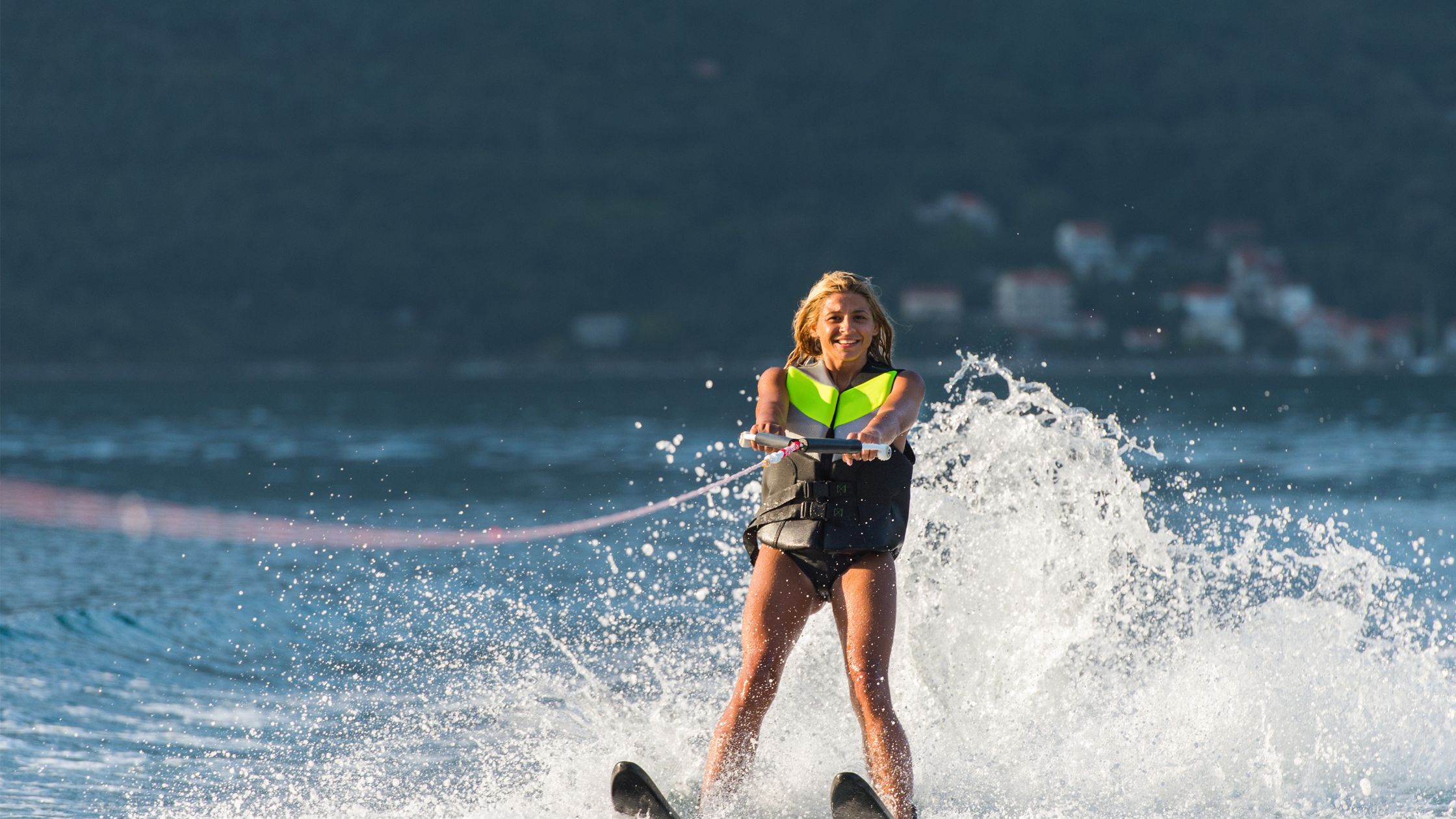
October 4, 2023
Water Skiing Essentials: Tips and Tricks for a Thrilling Experience
Water skiing is an exhilarating surface water sport where individuals ride on one or two s...
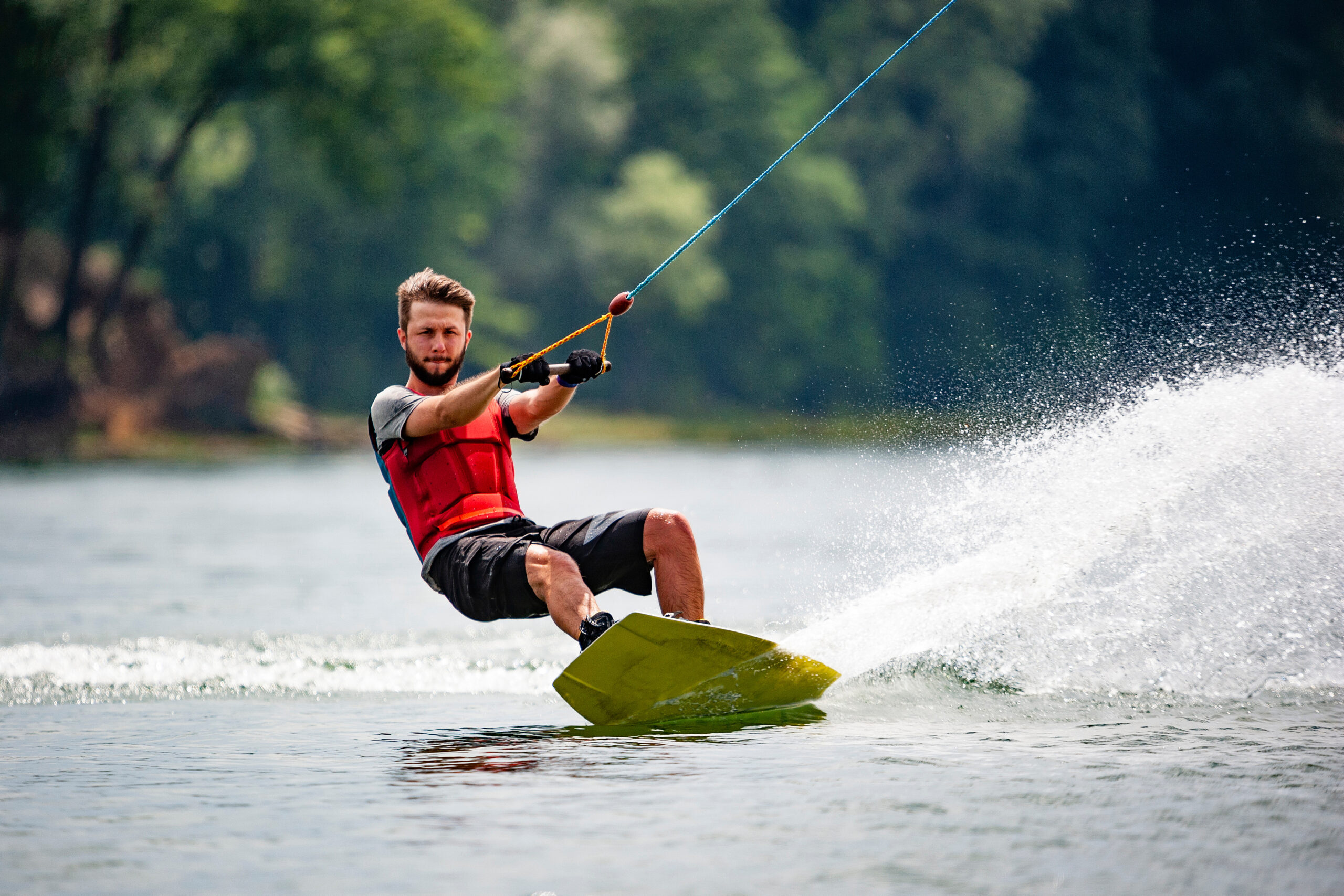
Wakeboarding Fun: Tips and Techniques for Every Skill Level
Wakeboarding is a thrilling water sport that has captured the interest of adrenaline seeke...
Don't have an account yet? Register
Already have an account? Sign In
Reset Password
Please enter your username or email address, you will receive a link to create a new password via email.
- Motor Boating
- What’S The Fastest Power Boat In The World?

What’s the Fastest Power Boat in the World?
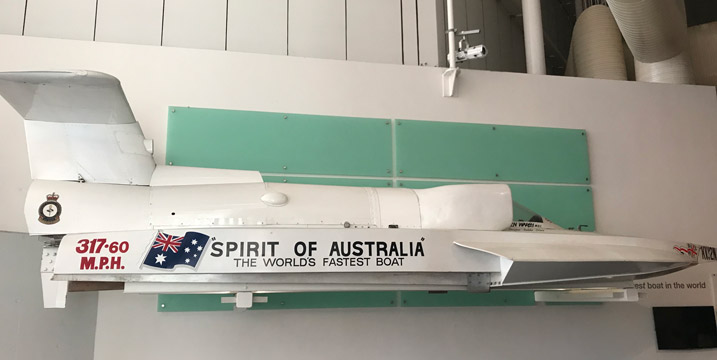
Robertsf2012 / CC BY-SA (https://creativecommons.org/licenses/by-sa/4.0)
Across many walks of life, human beings are obsessed with speed. Some people love the thrill of watching motor vehicle racing. Others try to max out their speed on a bicycle. Still others prefer watching the Olympic games, witnessing races on foot and in a variety of other sports.
But for those of us who love being on the water, there’s nothing better than a super-fast power boat.
Power boats have been around as early as the internal combustion engine, which rose to prominence in the 19th Century. But as you can imagine, countless innovations have transformed not only how power boats look and function, but also how fast they can go when unimpeded.
Whether you’re in the market for a new power boat of your own, hoping to reach new speeds on the water, or are just fascinated by the thrill of seeking speed on open ocean, you’ll want to know: what’s the fastest power boat in the world?
How Fast Is Normal?
First, let’s establish a metric for how fast a “normal” boat can go. Top cruising speed for a yacht is something like 21 to 23 knots, or around 24 to 26 mph, while most yachts go much slower when actually “cruising.” If you look at some of the most powerful and popular power boats available to the public today, many of them can achieve a top speed close to, or even exceeding 100 mph—four times as fast as top cruising speed for a yacht—but even that speed pales in comparison to what some of the fastest power boats in the world have been able to achieve.
The Spirit of Australia: Fastest Power Boat in the World
The Guinness World Record for the top speed achieved on water is officially 275.97 knots, or over 317 mph, set by a craft called the Spirit of Australia back on October 8, 1978. It remains the record to this day, more than 40 years later. The record-setting run was at Blowering Dam Lake, in New South Wales, Australia. On a similar run in November 20, it is claimed that the craft was able to reach a better top speed at the same location, at nearly 345 mph. However, this is considered an “unofficial” speed.
As you might imagine, the Spirit of Australia was specifically engineered to set a water speed record, and was not commercially available for people to use when casually cruising on the ocean. It was designed (and operated) by a man named Ken Warby, who was able to engineer the vessel in his own backward.
The secret to the Spirit of Australia’s power was a set of Westinghouse J34 jet engines, which as the name suggests, were also used for aircraft and fighter jets. Together, they were able to generate 3,000 horsepower. Currently, the Spirit of Australia is retired, on permanent display at the Australian National Maritime Museum.
In the years (and decades) following Warby’s world record, there have been many world record attempts by other boating manufacturers and speed enthusiasts. However, none have been able to break the record set back in 1978.
Other Top Speed Contenders
It’s also worth noting some of the other power boats that have either come close to approaching the Spirit of Australia’s record, or have established a reputation of their own.

Sheppane at English Wikipedia / CC BY-SA (https://creativecommons.org/licenses/by-sa/3.0)
For example, there’s the Bluebird K7, one of the oldest pioneers in the history of speedboats. Helmed by Donald Campbell, the Bluebird set 7 separate speed run records between July 1955 and December 1964. Even back in 1964, this vessel was able to set a record by traveling 276 mph on the water. The story has a sad ending, however, as Campbell lost his life while attempting to set an even faster record, at 300 mph, back in 1967. The wreckage of the Bluebird was not recovered until a period between 2000 and 2001. Those remnants are currently preserved at the Ruskin Museum in Northern England.
There’s also the humorously named Problem Child, a more modern power boat that is currently the world’s fastest nitro drag boat. Sporting an incredibly powerful 8,000 horsepower engine, the Problem Child can reach a top speed of 262 mph in a matter of 3.5 seconds—which exceeds the performance of even speed-oriented land vehicles. The Problem Child is widely regarded as the fastest machine on water today, with consistent speeds of more than 250 mph.
Not far behind it is the Mystic Powerboats C5000 Turbine, powered by twin 1850 horsepower engines for a total power of 3,700 HP. Cruising speeds of 150 mph are easy for this boat, but its highest record speed is 250 mph. Even more impressive, the Mystic Powerboats C5000 Turbine can host up to 6 passengers—though it may not be able to reach those record-approaching top speeds with extra passengers on board.
Buying a Power Boat of Your Own
Unfortunately, most of the record-setting vessels in this article aren’t available for purchase; instead, they were designed as individual crafts with a singular purpose. However, there are hundreds of power boats available to quench your thirst for speed on the water—and many of them are capable of reaching speeds close to, or even exceeding 100 mph.
If you’re interested in getting a power boat for speed performance, make sure you get to know the variables that can affect your speed in the open water, including the brand of the manufacturer, the type of engine, the shape of the craft, and the carrying capacity.
Are you interested in getting a super-fast power boat of your own? Check out our selection of power boats and yachts for sale , from dozens of different manufacturers. Buy new or used, from individuals and manufacturers all over the world to find your best possible fit!
Share this article
You might like.
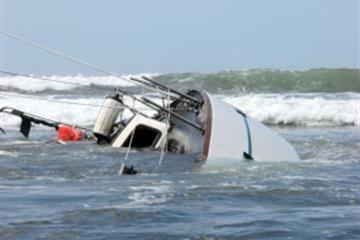
Sign up to our newsletter
By submitting this form, you agree to our Privacy & Cookie Policy
Change units of measure
This feature requires cookies to be enabled on your browser.
Show price in:
Show lengths, beam and draft in:
Show displacement or weight in:
Show capacity or volume in:
Show speed in:
Show distance in:

- 2024 BOAT BUYERS GUIDE
- Email Newsletters
- Boat of the Year
- 2024 Freshwater Boat and Gear Buyers Guide
- 2024 Boat Buyers Guide
- 2024 Water Sports Boat Buyers Guide
- 2023 Pontoon Boat Buyers Guide
- Cruising Boats
- Pontoon Boats
- Fishing Boats
- Personal Watercraft
- Water Sports
- Boat Walkthroughs
- What To Look For
- Best Marine Electronics & Technology
- Watersports Favorites Spring 2022
- Boating Lab
- Boating Safety

2020 Velocity 260 Bay
- By Jeff Hemmel
- Updated: April 20, 2020
Boasting a pedigree that includes multiple speed records, the Velocity 260 Bay hull features a deep, chop-busting V at the bow, a stepped transom to limit bow rise, and a pad bottom to generate lift and reduce fuel consumption.
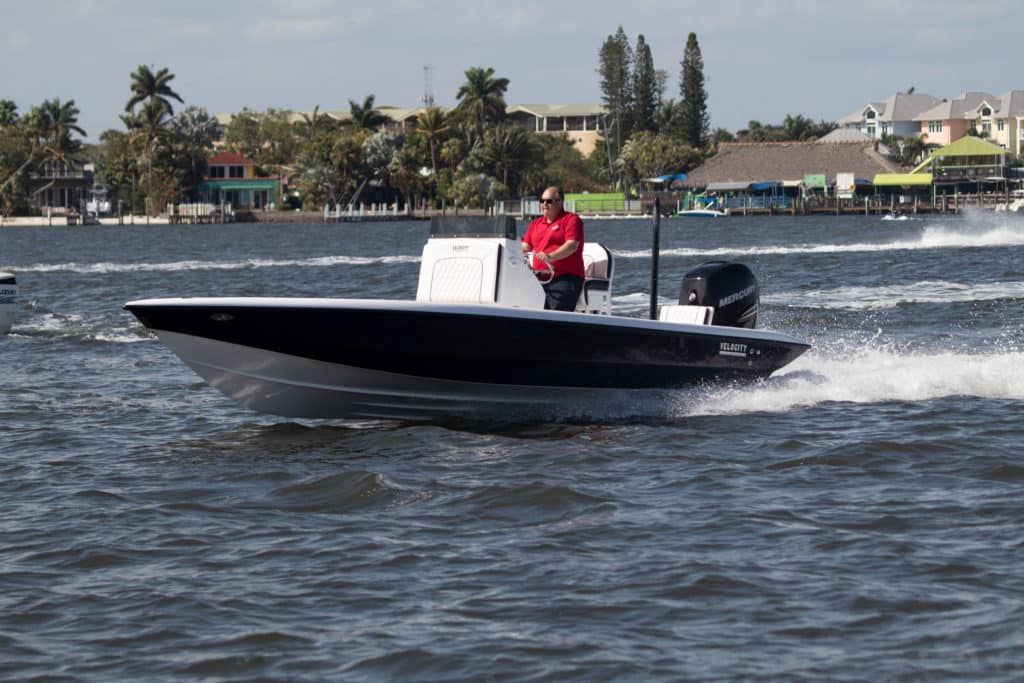
Clearing the no-wake zone, we slammed the throttle forward, and the 260 smoothly leapt onto plane, a Mercury 350 Verado outboard with lab-finished prop continuing to pour on the coal till the boat peaked at 65.9 mph. Dropping the trim a few notches and cranking the wheel at speed, we came about in knifelike fashion. Later, the term knife came to mind again as the hull sliced efficiently through the waves, reverse chines knocking down the spray while the 260 Bay produced a solid, quiet ride.
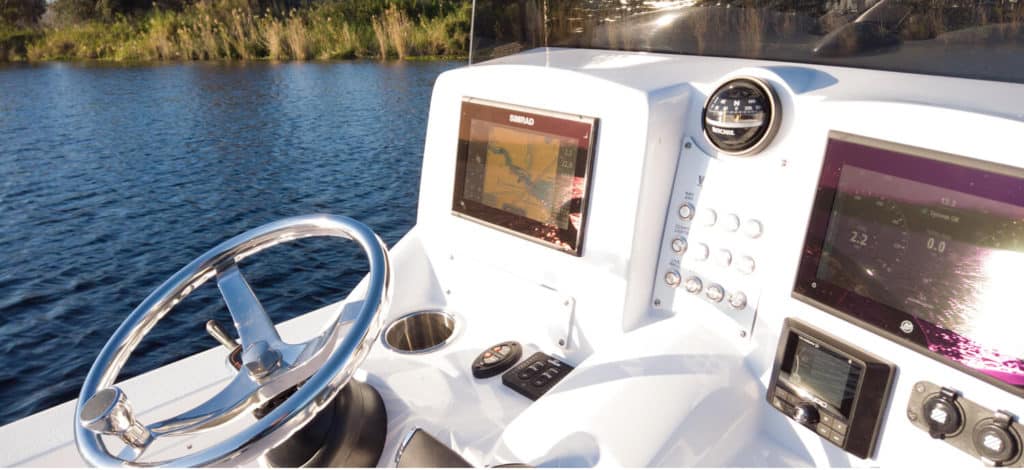
Interior and Accessories
When it comes time to chase fish, the hull’s minimal draft, coupled with a standard Bob’s Machine Shop jack plate, enables the 260 Bay to hunt the flats. Three insulated fish boxes are at the ready to store your catch, two on the aft casting platform, and one larger, in-sole box with macerator forward. Livewells are placed both fore and aft. Rod lockers, as well as a large stowage box, hide below the 6-foot-long casting deck at the bow. Rod racks are under each gunwale.
There are two choices for helm seating: our test boat’s beefy, aluminum-tubed leaning post with flip-up bolsters, or a fiberglass-enclosed alternative. The former features two tackle drawers, the latter an enclosed tackle station.
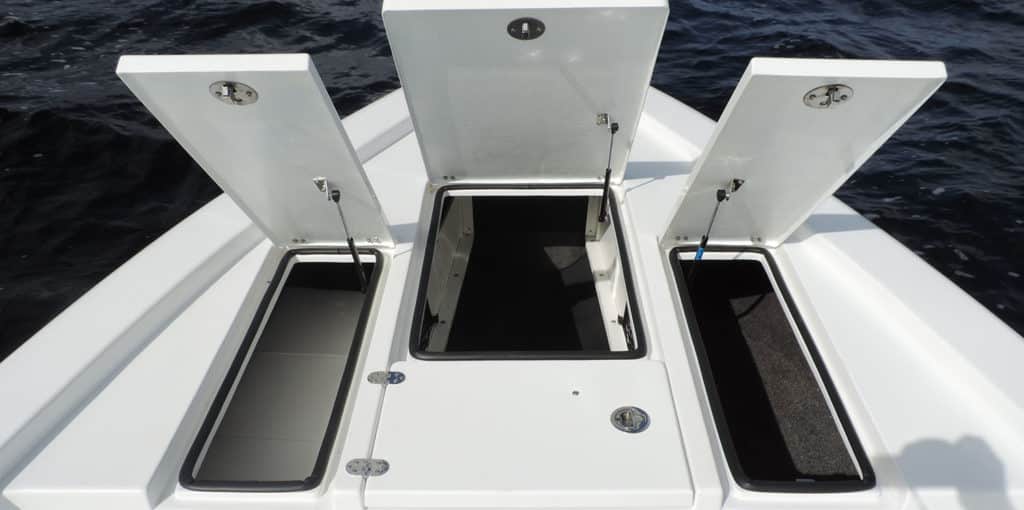
The nicely faceted helm includes flat surfaces for two displays; on our test boat, the standard 9-inch -Mercury VesselView flat screen was paired with an optional Simrad GO9. Notably, jack-plate control is blinker-style behind the wheel. A standard Ritchie compass is stylishly integrated into the design.
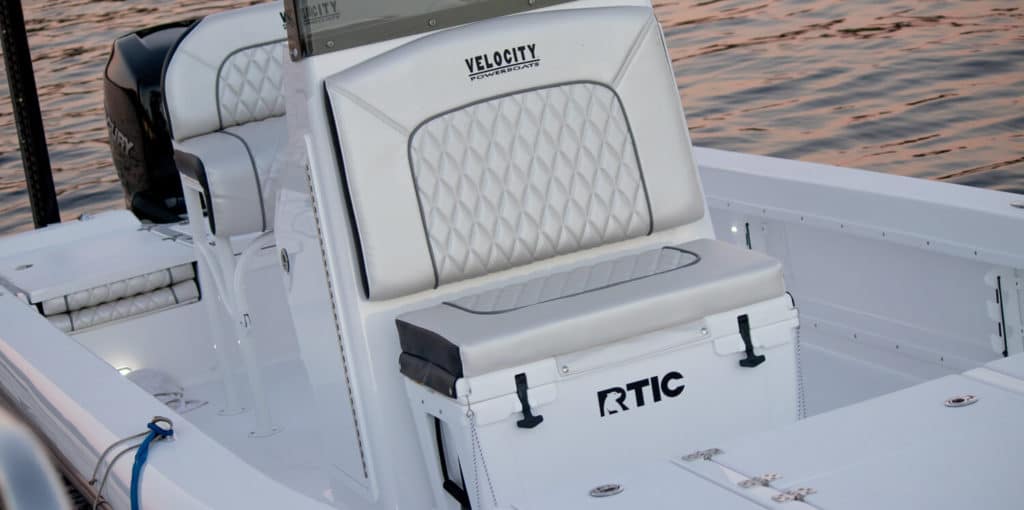
A pair of flip-up jump seats are concealed beneath the aft platform, when passengers need a perch. A nicely padded seat with high backrest sits atop the RTIC cooler mounted in front of the console. Optional removable cushions can be added atop the forward deck.
How We Tested
- Engine: Mercury 350 hp Verado 350
- Drive/Prop: Outboard/Mercury Fury 4 14.5″ x 24″ 4-blade stainless steel
- Gear Ratio: 1.75:1 Fuel Load: 68 gal. Crew Weight: 360 lb.
High Points
- All parts, from the hull and deck to smaller components, are made with vacuum infusion or vacuum bagging for an advantageous strength-to-weight ratio.
- Gemlux friction hinges eliminate the need for gas hatch struts, and hinge stops guarantee hatches won’t mar the adjoining fiberglass.
- No raw painted glass here; all compartments are nicely finished off in gelcoat.
- JL Audio sound system includes an amplifier and Simrad interface.
- Leaning post and cooler seat could benefit from additional handholds, especially given the aggressive nature of the hull.
- Tiny storage compartment drain holes seem destined to plug with gunk.
- Prototype test boat porpoised a bit at high speed. Velocity says it will take steps to eliminate the glitch in production models.
Toughest Competitor
Pathfinder ’s 2600 HPS (starting at $105,120 with a 350 hp Yamaha outboard) likewise mixes go-fast speed, fishability and skinny-water ability.
Pricing and Specs
Speed, efficiency, operation.
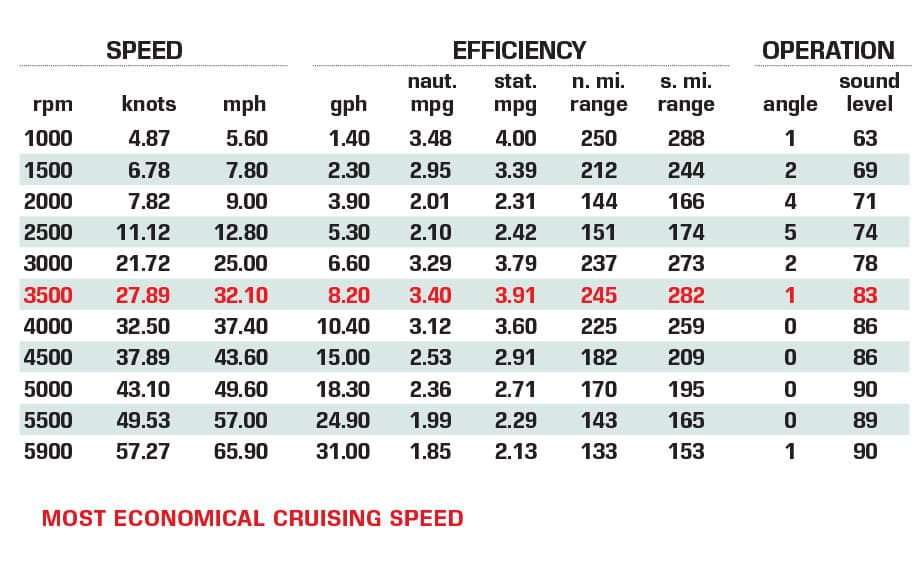
Velocity Powerboats – Sanford, Florida; 386-679-5682; velocityboats.com
- More: 20-30ft , boat tests , Boats , Fishing Boats , outboards , Velocity Powerboats
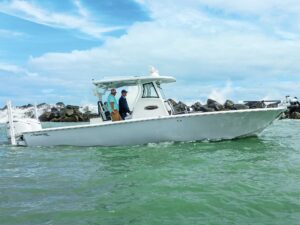
Boat Test: 2024 Tidewater 3100 Carolina Bay
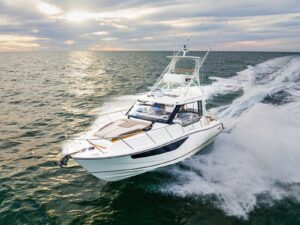
Boating On Board: Boston Whaler 365 Conquest
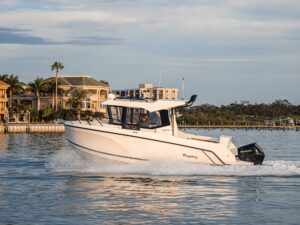
Boat Test: 2024 Bayliner Trophy T23 Pilothouse
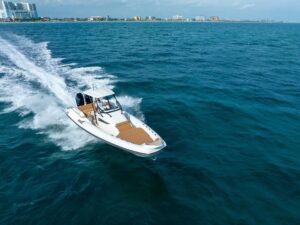
Boat Test: 2024 Nuova Jolly Prince 33 CC
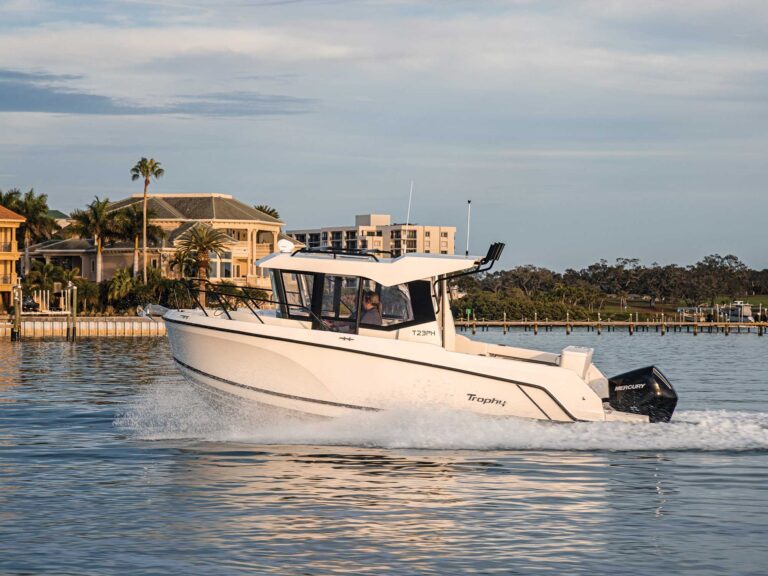
What to Do if Your Boat’s Engine Dies
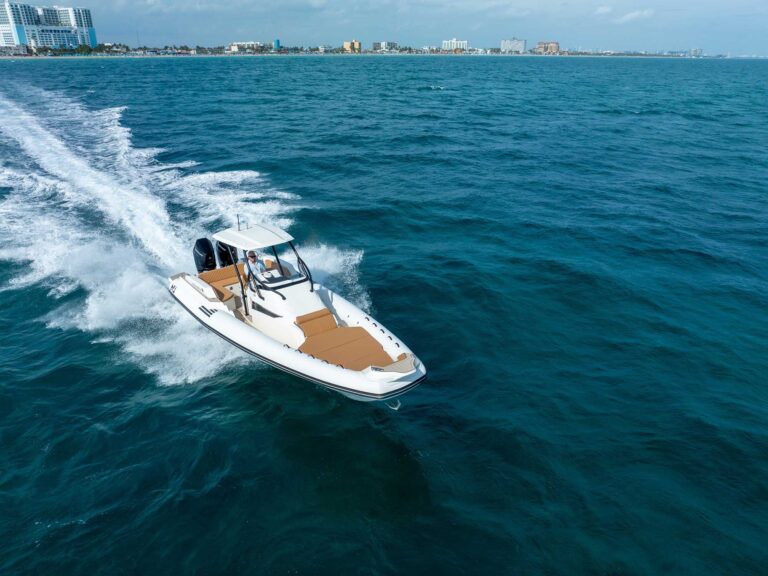
ProTournament Elite Gen 3 Chargers

- Digital Edition
- Customer Service
- Privacy Policy
- Cruising World
- Sailing World
- Salt Water Sportsman
- Sport Fishing
- Wakeboarding
Many products featured on this site were editorially chosen. Boating may receive financial compensation for products purchased through this site.
Copyright © 2024 Boating Firecrown . All rights reserved. Reproduction in whole or in part without permission is prohibited.

How Fast Do Boats Go? Exploring Watercraft Velocity
Categories Boating

Boats have always captivated our imagination, evoking a sense of wonder with their seamless movement across the water, combining speed and elegance in a unique way. Whether you find yourself enthralled by the art of sailing, enthused by the power and exhilaration of speedboats, or simply curious about the diverse capabilities of various types of boats, delving into the realm of boat speed is an intriguing pursuit. In this article, we will embark on a journey to explore the multifaceted factors that influence a boat’s velocity, the distinct categories of boats and their characteristic speeds, astonishing world records achieved in the pursuit of speed, and, perhaps most importantly, the crucial safety considerations that accompany high-speed boating.
Types of Boats and Their Speeds
Different types of boats are designed for specific purposes, and their speeds can vary greatly. Let’s explore some common categories of boats and their typical speeds.
Recreational Boats
Recreational boats, such as fishing boats or small runabouts, are designed for leisure activities on the water. They generally have moderate speeds ranging from 10 to 40 miles per hour (16 to 64 kilometers per hour). These boats prioritize comfort, stability, and versatility rather than outright speed.
Speedboats are built for high performance and exhilarating speed. They can reach impressive speeds ranging from 40 to 100 miles per hour (64 to 161 kilometers per hour). These sleek and agile vessels often feature powerful engines, streamlined designs, and specialized hulls to maximize speed and maneuverability.
Yachts are luxurious and spacious vessels designed for cruising and entertaining. While they may not prioritize speed as much as other boat types, modern motor yachts can still achieve speeds of 20 to 50 miles per hour (32 to 80 kilometers per hour). Yachts are designed to offer comfort, style, and long-range capabilities for extended trips on the water.
Sailboats harness the power of the wind to propel themselves, and their speeds can vary depending on the wind conditions and boat size. Smaller sailboats can reach speeds of 5 to 10 knots (6 to 12 miles per hour or 9 to 19 kilometers per hour), while larger racing sailboats can achieve speeds of 15 to 25 knots (17 to 29 miles per hour or 28 to 46 kilometers per hour).
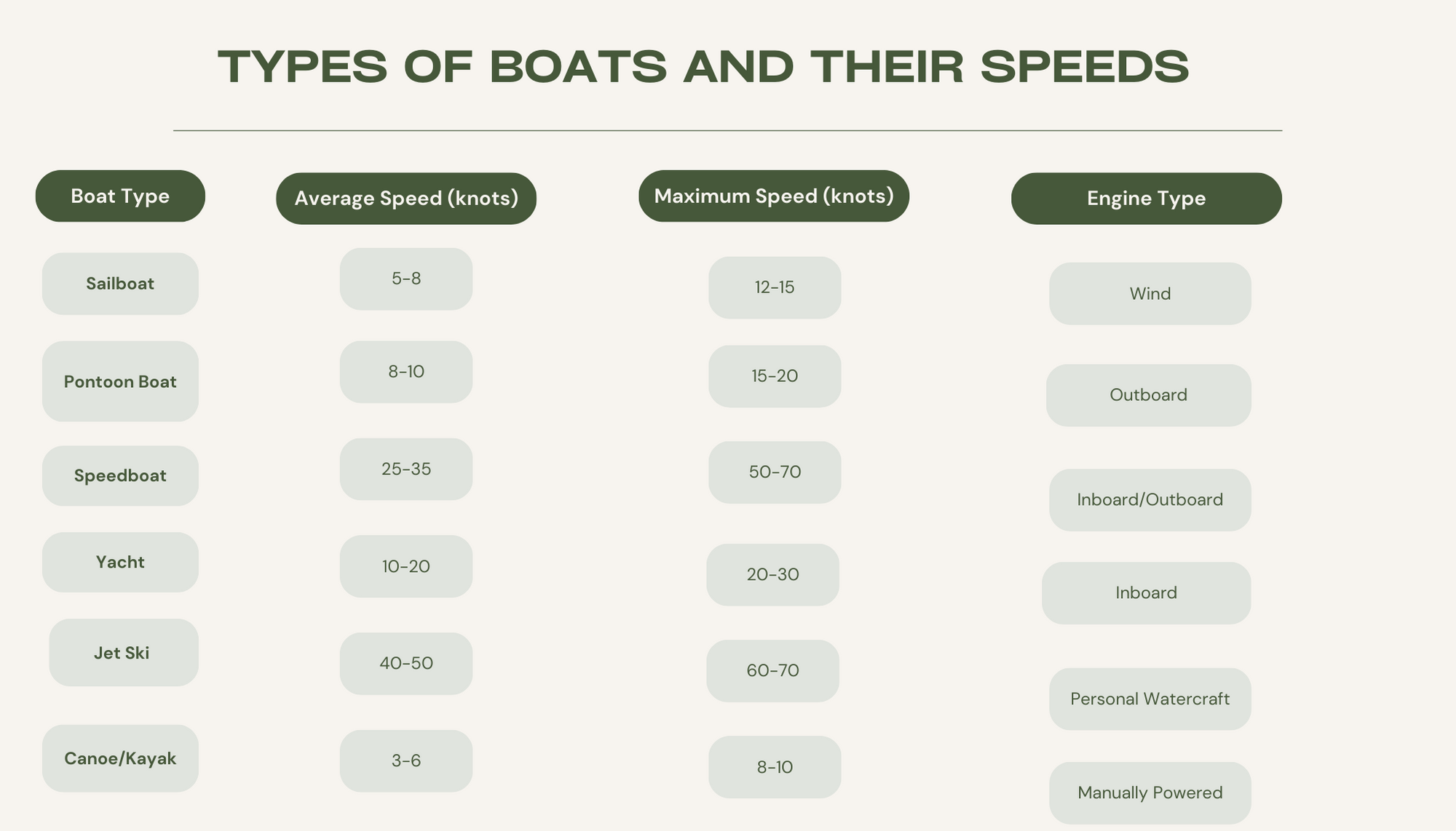
Factors Affecting Boat Speed
Several factors contribute to a boat’s speed, and understanding them can provide valuable insights into the performance of different vessels.
1. Hull Design
The design of a boat’s hull plays a crucial role in its speed and efficiency. Hulls can be designed for different purposes, such as planning hulls for speedboats or displacement hulls for sailboats. Factors like hull shape, width, length, and weight distribution influence a boat’s ability to cut through the water and achieve higher speeds.
2. Engine Power
The power of a boat’s engine is a significant determinant of its speed. The engine’s horsepower and torque directly impact how quickly the boat can accelerate and maintain its top speed . Higher-powered engines are generally found in speedboats and racing vessels, allowing them to reach impressive speeds.
3. Weight and Size
The weight and size of a boat affect its speed and maneuverability. Lighter and smaller boats tend to have higher speeds due to reduced drag, while larger and heavier vessels may sacrifice some speed for stability and capacity. The materials used in the boat’s construction, such as fiberglass or aluminum, also influence its weight and overall performance.
4. Water Conditions
The water body conditions in which a boat operates can significantly impact its speed. Calm and still waters provide optimal conditions for achieving higher speeds, whereas rough or choppy waters can slow down a boat and make navigation challenging.
5. Propeller Efficiency
The efficiency of a boat’s propeller affects its speed and acceleration. Factors like the number of blades, pitch, and material influence the propulsion efficiency and, ultimately, the boat’s speed. Propellers come in various designs and sizes, each offering different performance characteristics.
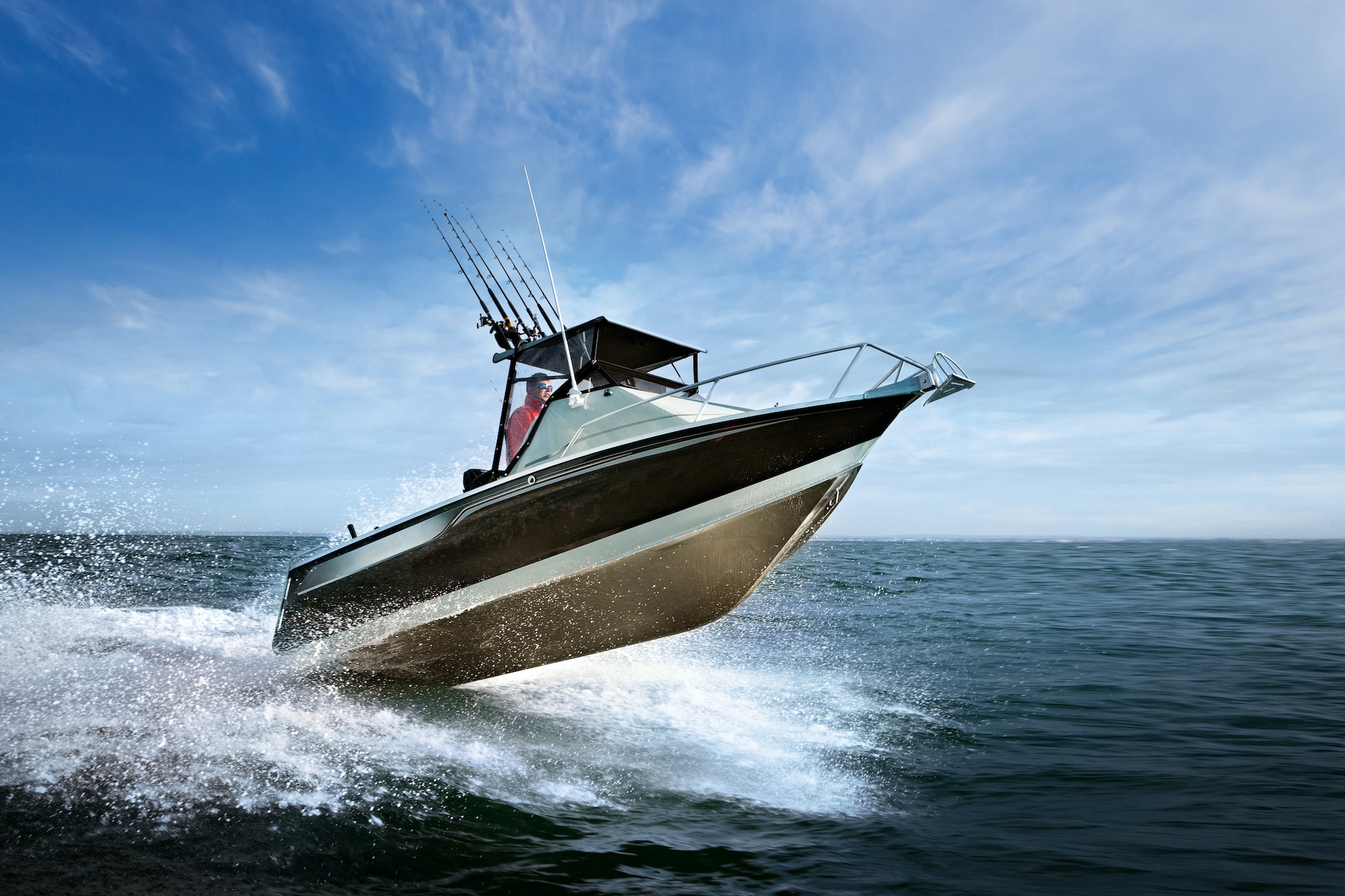
Safety Considerations
When operating a boat, safety should always be a top priority. Here are some important safety considerations to keep in mind:
- Always wear a life jacket or personal flotation device (PFD) when on a boat, regardless of the speed or conditions.
- Follow all local laws and regulations regarding boating, including speed limits and navigation rules.
- Be mindful of other vessels, swimmers, and obstacles in the water to avoid collisions.
- Maintain regular maintenance and inspections of your boat to ensure its safety and performance.
- Consider taking a boating safety course to improve your knowledge and skills.
By prioritizing safety, you can enjoy the thrill of boating while minimizing risks and ensuring a positive experience for everyone on board.
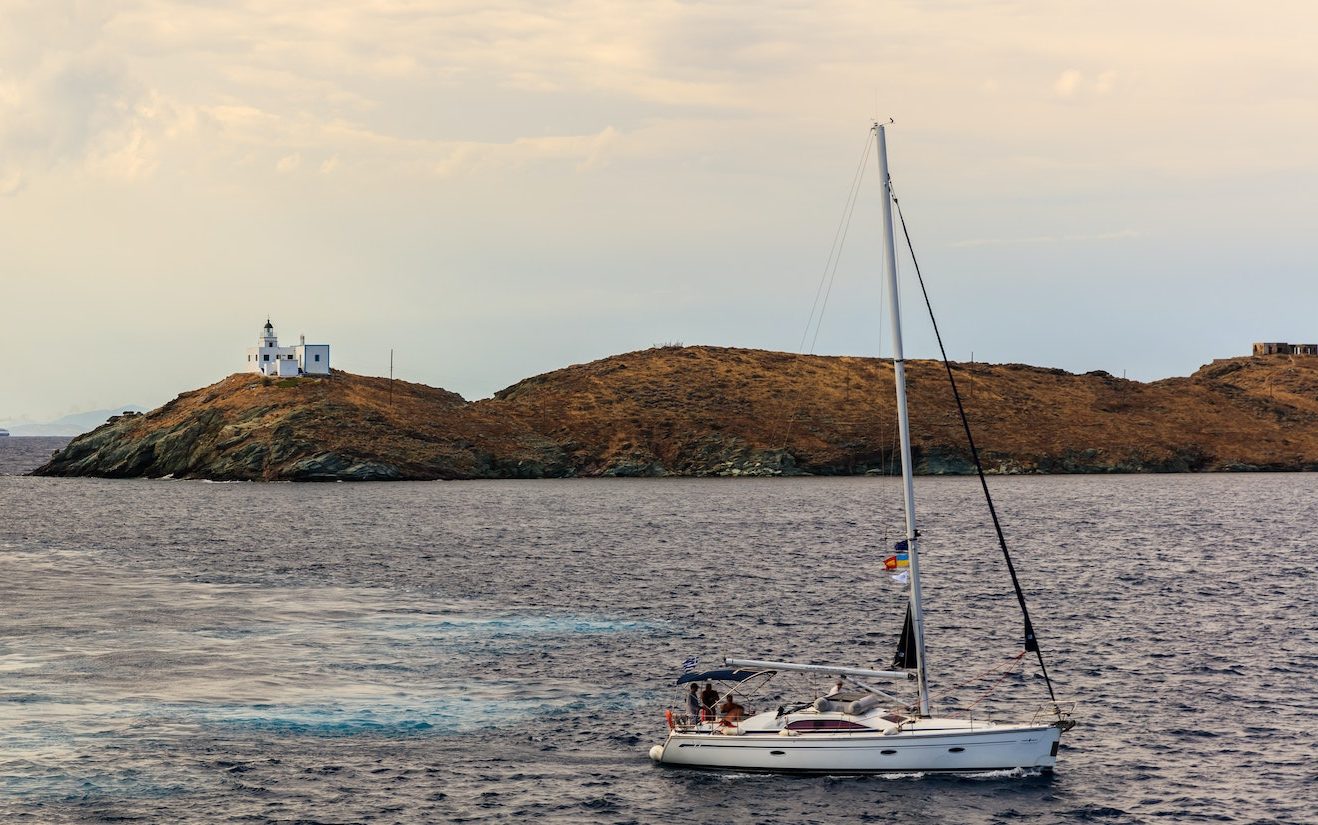
Boat Speed Records and Achievements
Outright Speed Record: The current outright speed record for a boat is held by the Spirit of Australia, piloted by Ken Warby. On October 8, 1978, Warby reached a speed of 511.11 kilometers per hour (317.60 miles per hour) at Blowering Dam in Australia. This record still stands today.
Sailboat Speed Record: The current record for the fastest sailboat is held by the Vestas Sailrocket 2. On November 24, 2012, Paul Larsen piloted the Vestas Sailrocket 2 to a peak speed of 65.45 knots (121.21 kilometers per hour or 75.45 miles per hour) over a 500-meter course in Walvis Bay, Namibia.
Powerboat Speed Record: The current powerboat speed record is held by the Team Australia boat, which achieved a top speed of 511.11 kilometers per hour (317.60 miles per hour) on November 20, 2018. The record-breaking run took place on Lake Dumbleyung in Western Australia.
Transatlantic Crossing Record: The current record for the fastest transatlantic crossing by a sailing boat is held by the trimaran IDEC SPORT, skippered by Francis Joyon. On June 26, 2017, Joyon completed the crossing from Ambrose Light in New York to Cape Lizard in the United Kingdom in just five days, 2 hours, 7 minutes, and 42 seconds.
Around-the-World Sailing Record: The current record for the fastest circumnavigation of the world by a sailing vessel is held by IDEC SPORT, skippered by Francis Joyon. On January 26, 2017, Joyon and his crew completed the journey in just 40 days, 23 hours, 30 minutes, and 30 seconds.
Solo Transatlantic Record: The current record for the fastest solo transatlantic crossing by a monohull sailboat is held by Alex Thomson on Hugo Boss. On July 16, 2017, Thomson completed the crossing from Ambrose Light in New York to The Lizard in the United Kingdom in 8 days, 22 hours, 8 minutes, and 28 seconds.
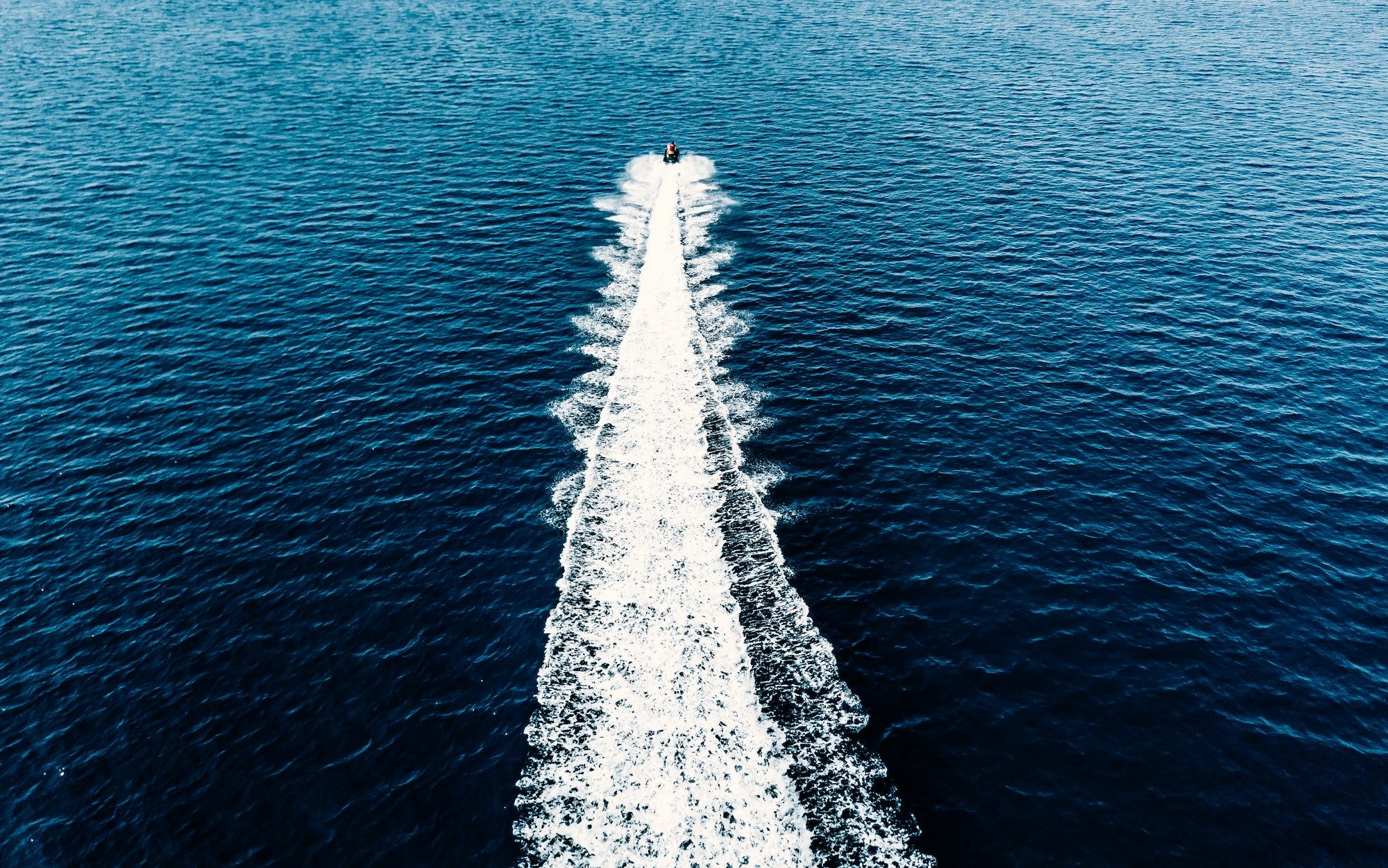
What is the world record for the fastest boat?
The world record for the fastest boat is a boat that can travel at a speed of over 450 miles per hour. The previous world record was set by a boat that could travel over 371 miles per hour.
The current world record holder is a boat that can travel over 317 miles per hour. This is an incredibly fast speed for a boat, and it is a testament to the engineering and design of these boats.
What are the fastest boats?
The fastest boats in the world, such as hydroplanes and catamarans, can reach speeds of over 200 mph. This speed is due to their lightweight hulls for quick acceleration and turning. Their light weight also makes them less stable, but this is countered by using a large wing or sponsons that provide stability at high speeds. The fastest boat in the world is currently the H1 Unlimited Hydroplane. It can travel at speeds of over 300 mph!
What are the slowest boats?
There are a few different types of boats, and each style has its own average speed. The slowest boats are sailing, racing, go-fast, and production boats. The fastest boats are jet skis, hydrofoils, and hovercrafts.
Sailing boats: the average speed of a sailing boat is about 5 knots (6 mph). That’s about the speed of a brisk walk.
Racing boats: racing boats are designed to go as fast as possible, reaching speeds up to 80 knots (92 mph).
Do boats go faster than cars?
No, boats go slower than cars because water is denser than air. The main reason behind the slowness of a boat is friction.
Boats must push water out of the way to move, creating resistance. The faster a boat goes, the more resistance it experiences.
On the other hand, cars travel through the air, which is much less dense than water. This means that they don’t have to work as hard to move forward and can reach high speeds relatively easily.
Are 24 knots fast for a boat?
The average speed for a boat is 5 knots. However, the maximum speed for a sailboat is 185 km or 115 miles. So, 24 knots would be considered fast for a boat.
Can boat speed be increased by modifying the engine?
Yes, upgrading the engine or modifying its components can increase a boat’s speed. However, it’s essential to ensure the modifications are legal, safe, and within the manufacturer’s guidelines.
Are there any speed restrictions on the water?
Yes, different bodies of water have speed limits and regulations in place to ensure safety. It’s important to be aware of and abide by these restrictions.
What are the risks of traveling at high speeds on a boat?
Traveling at high speeds on a boat carries risks such as reduced maneuverability, increased potential for accidents, and the need for advanced skills and experience. Adhering to safety guidelines and using proper equipment is crucial to mitigate these risks.

- CLASSIFIEDS
- NEWSLETTERS
- SUBMIT NEWS
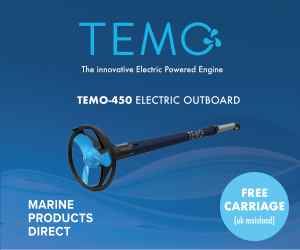
When boating meets aviation technology: The new aerodynamic speed power boats by A2V
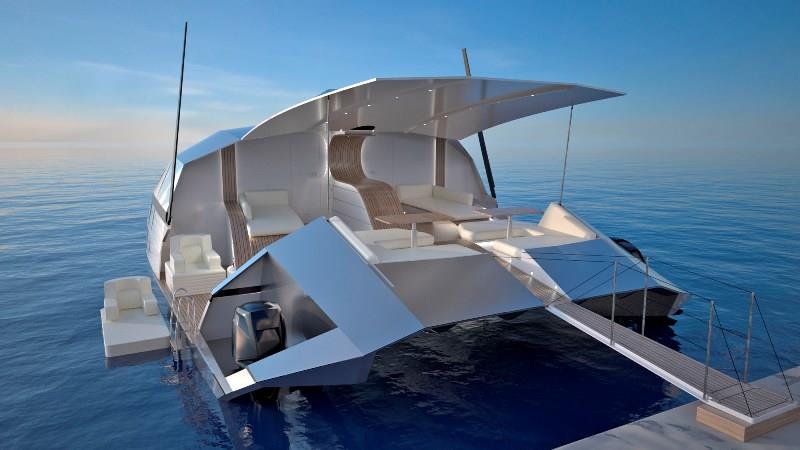

Related Articles
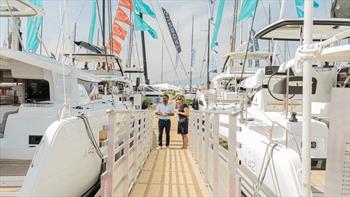
Boat Speed Calculator
Table of contents
The boat speed calculator determines the top speed of a boat based on the boat's power and displacement . If you wonder how fast a boat can go, this calculator will help you answer that. The calculator also utilizes a constant known as Crouch constant which differs based on the type of the boat.
The formula for the top speed of a boat is used by designers to perform preliminary design analysis of the hulls. This helps in keeping the cost of building a boat in check (visit the boat loan calculator for more). Read on to understand how to calculate the speed of your yacht using Crouch's formula and to know how much horsepower do I need for my boat?
What is boat speed — Calculating using Crouch's formula?
The speed of the boat, in simple words, is how fast it can go. However, unlike land vehicles, this speed is not a ratio of distance and time. The speed of a boat having an engine to deliver P horsepower and displacing D pounds is written as:
where S is the boat speed and C is the Crouch constant. The above equation is known as Crouch's formula.
Note: The formulation and value for the Crouch constant are specific for units such as the speed in miles per hour and displacement in pounds.
💡 Our tools can convert units automatically, but if you'd like to learn how to do these conversions yourself, then our speed conversion and torque to hp calculator could come in handy!
What is displacement?
The displacement for a boat is defined as the volume of water displaced . The volume is then converted to weight. This property of a ship is an application of Archimedes' principle . In other words, the displacement of a boat is its weight. This weight is usually measured in tonnes or pounds. For instance, a modern US Navy Gerald R. Ford-class aircraft carrier displaces about 100,000 tons at its full load, whereas a 17th-century fishing boat displaces only about 13 tons. The tonnage of the ship varies as per its class and purpose.
Keep reading about Archimedes' principle at our Archimedes' principle calculator and find out if an object sinks or floats in a liquid!
Crouch constant
The Crouch constant depends on the type of boat . The constant is applicable to a wide variety of boats, from runabouts to high-speed racing boats. It does not take the hull length into account. The table below has the value of the Crouch constant for different types.
How to calculate boat speed using this calculator?
Follow the steps below to calculate boat speed:
Step 1: Enter the shaft horsepower value, P .
Step 2: Insert the boat's displacement , D .
Step 3: Choose the Crouch constant , C from the list of boat types , or you can directly enter the value.
Step 4: The boat speed calculator will now return the value of boat's top speed.
Example of using the boat speed calculator
Calculate the speed of a racing hydroplane having an engine that delivers 3000 hp and displaces 6800 pounds of water.
To calculate boat speed :
Step 1: Enter shaft horsepower value P = 3000 hp .
Step 2: Insert the boat's displacement , D = 6800 lbs .
Step 3: Choose the Crouch constant , C from the list for hydroplanes, i.e., C = 220 .
Step 4: Using the Crouch's formula: S = √(P / D) × C = √(3000 / 6800) × 220 = 146.13 mph i.e., the speed of the hydroplane is about 146.13 miles per hour.
Alternatively, you can also run this calculator backward to know how much horsepower I need for my boat to achieve a certain speed. Say you want a top speed of 150 miles per hour for your 6,000 lb hydroplane. You can then:
Step 1: Enter top speed value S = 150 mph .
Step 2: Insert the boat's displacement , D = 6000 lbs .
Step 4: The calculator will use Crouch's formula to return the horsepower value as: Power = (P / C)² × D = (150 / 220)² × 6000 = 2789 hp
Therefore, you need an engine to deliver about 2800 hp to take your boat as fast as 150 mph .
How do I calculate a boat's top speed?
To calculate the boat speed:
Divide the power delivered by the boat to the displacement.
Find the square root of the result from step 1.
Multiply by the Crouch constant.
S = √(P / D) × C
What is Crouch's formula?
Crouch's formula is the equation to find the top speed of a boat based on its power P and tonnage D . The speed of the boat, S is given by the equation.
What is the value of Crouch's constant for a racing boat?
A racing boat has the value of Crouch constant around 210 .
What is the value of Crouch's constant for runabout boats?
An average runabout has the value of Crouch constant around 150 whereas it can go up to 190 for high-speed runabouts .
Shaft horsepower (P)
Boat displacement (D)
Crouch's constant (C)
🚚 FREE US SHIPPING ON ORDERS OVER $25 🚚

Average Boat Speeds: Pontoon, Cruiser and Sail Speed Examples

How fast do boats go on average?
Is a fast boat the exception or the rule for average boat speeds?
What horsepower can you realistically expect from the average boat purchase?
Well, these questions can be answered in lots of different ways.
The fastest boat speed record ever was 317.6 MPH. It was achieved by a man named Ken War who was using a speedboat he named the Spirit of Australia . To be fair, though, when that boat made its water speed record run back in 1978, it was powered not by a propeller but by a jet engine. Most boats don't go quite that fast (and we're thankful for that).
Motorboats designed primarily for speed - known as rum-runners in decades past and often called cigarette boats (due to their slender shape) or simply go-fast boats today - can achieve speeds up to 90 MPH with relative ease over calm flat waters.
Even that's quite a bit faster than the average boat speed, and unless you're considering a career in smuggling (which we don't recommend, by the way), it's probably quite a bit faster than you need to travel over the water.
So, let's talk about average recreational boat speed statistics that are a bit more practical.
Why Boat Speed Matters
Going fast in a boat can be lots of fun.
The enjoyment that comes from speed is a huge plus for adrenaline-seeking boaters. That's one reason why knowing how fast a boat goes is important.
It's also important to consider boat speed when you're getting a boat for water activities. Think about the types of activities for which your ideal boat will be used. You should even consider whether you live in, or want to enjoy your boat in, high-altitude areas .
Even then, desired speeds can vary. The best speed for a towing activity such as water skiing can vary from 10 MPH to 35 MPH. Lower speeds are better for younger skiers and certain trick-skiing activities, and the higher speeds are for more experienced water skiers completing slaloms or jumps.
As you can see, some action-loving boaters might need a craft with plenty of potential for speed to soar over those saltwater waves .
The fisherman who likes to slowly troll through calm waters or toss out a line and an anchor, on the other hand, might do well enough with a boat that only cruises along at a top speed of 15 MPH.
If you use your boat for long trips, then balancing speed and fuel efficiency is important.
How you're going to be using your boat should inform the ideal average and top speed ratings of the boat you ultimately buy.
Don't just go looking for a super fast boat that you might not ever really take advantage of. What a waste that would be!
Average Pontoon Boat Speeds
The trusty, stable pontoon boat can travel a good deal faster than many people think.
Pontoon boat speeds can surpass 30 MPH under the right conditions. A few pontoon boats can even reach the 35 MPH mark thanks to larger engines and great conditions.
The G3 Suncatcher pontoon boat , with a 90 HP motor, can easily go more than 30 MPH .
A 20-foot Bass Buggy with a 60 HP engine, on the other hand, will only go around 15 MPH .
A middle-of-the-road option in terms of average pontoon boat speed is the 21-foot Triton pontoon boat and its 90 HP engine. This boat's combination of speed and strength gives it a top boat speed of around 25 MPH even when you have a few friends aboard weighing it down.
Average Cruiser Speeds
For cruiser-style motorboats that are in the price range of many American families, let's discuss a few options that give a good sense of average powerboat speed.
The Marlow-Pilot 32 has a relatively slow top cruising speed of 16 MPH , but its range at moderate speeds is the more remarkable thing about the vessel. It can travel more than 800 miles without re-fueling.
If you want a motorboat with a bit more speed, such as what a sport fisherman might need, consider the stats of the Pursuit SC 365i Sport Yacht . It can come close to 50 MPH at top speed and cruise comfortably in the 30 MPH range.
Finally, if you're wondering how fast larger motorboats go, the 40-foot Carver C40 Command Bridge cruises along at 30 MPH with ease and is suitable for use during multi-day trips.
Average Sailboat Speeds
Most people use sailboats because they savor the practice of harnessing the wind, not because they expect to go all that fast.
The average cruising sailboat, such as a celebrated Island Packet 420 , will sail along at an average speed of between 8 and 12 MPH under most decent circumstances.
The world speed record of a sailboat is a bit faster than that, at just over 75 MPH . That breakneck speed was achieved by the Vestas Sailrocket 2 in 2012.
And just for your interest, have you ever wondered how fast Columbus's ships sailed ? Experts agree that ships of the late 15th century likely cruised along at just under 4 knots and a likely top speed of 8 knots. That's an average boat speed of somewhere between 4 and 9 MPH .
Featured Boat Care Product
Check Price on Amazon - Better Boat Fabric Waterproof spray protects Bimini tops, canvas, upholstery and nylon from the inevitable spray of water. You can even use it on shoes, bags, luggage and car covers.
Average Boat Speed and Fuel Consumption
Going fast in a motorboat is lots of fun but it can also be very expensive.
To help get a picture of the direct relationship of average boat speed to fuel used, let's select the Formula 240 Bowrider motorboat as our example. This affordable and capable 24-foot speedboat is a common favorite for American families.
At a steady cruising speed of 7 MPH, the 240 Bowrider consumes about 3 gallons of fuel per hour. At twice that speed, around 15 MPH, it consumes over twice the amount of fuel, burning up around 7 gallons per hour.
Double that speed again and the boat consumes 11 gallons of fuel at around 30 MPH. The Bowrider can go well over 45 MPH.
Many powerboats offer relative fuel efficiency at their mid-range speeds, so puttering along at only a few miles per hour isn't necessary for fuel savings. You can cruise at an enjoyable clip and still conserve fuel.
Laws About Boat Speed
It's generally rather easy to figure out the speed limit when you're driving on a road. All you have to do is look for the posted speed limit sign. Knowing boat speed regulations laws is a bit trickier.
The limits aren't always posted and can change based on a myriad of factors, including the type of waterway, time of day (or night), type of boat and more.
And what's more, a boat speed limit is rarely a specific numerical figure.
Once you're out on the open water of a sea, ocean or large lake, it's safe to assume you can take your boat up to its top speed provided you can see the way ahead of you is safe and clear.
Closer to shore - on a river, in the bay or in other such areas - you have to be a bit more cautious.
Generally, you must watch out for "no wake zones," which are enforced in many places, including near docks and marinas, in canals and near the shore in many cases.
To remain in compliance with a No Wake Zone rule, a boat must travel slow enough that it doesn't produce a swell large enough to threaten others in the area (including other boaters, swimmers, animals and so forth).
Most motorboats produce a noticeable wake at speeds greater than 5 MPH. Yes, navigating the way through a no wake zone can be an exercise in patience. But the rules regarding boat speed were designed to help keep all people out on the water safe, from the family enjoying a trip in their pleasure yacht to the fisherman casting a line off of his sit-on-top kayak.
Keep these considerations in mind when you're choosing your boat and taking it out for a spin to test its full speed.

- choosing a selection results in a full page refresh
- Articles and Guides
Boat Speed Limits: How Fast You Should be Going?
25th jul 2023 by samantha wilson.

Driving a boat and driving a car are very different and the mechanics and skills for driving each vary considerably, the consequences of speeding can be just as dangerous for both forms of transport. Likewise, a car or boat driver must stay alert and situationally aware at all times, anticipating what will happen next.
Speeding in a boat is not often considered to be the danger that it is, but according to the US Coast Guard, in 2022, there were 4,040 boating accidents in the United States that involved 636 deaths and 2,222 injuries. These are sobering statistics, especially knowing that most could have been avoided by better speed management. Yet with a fatality rate of 5.4 deaths per 100,000 registered recreational boats, it’s fair to say that boating is still inherently safe, provided we all take reasonable precautions and follow the rules.

So what determines if a speed is safe for your boat? Are there boat speed limits? Here we’ll answer the following commonly asked questions;
How Do You Know When You Are Operating Your Vessel at a Safe Speed?
When it comes to operating your boat at a safe speed, the most important point to remember is that any vessel should be operated at a speed that allows sufficient time and distance to take necessary action to avoid an accident or collision . Unlike driving on the road, where speed limits are clearly established and marked, it’s often not the case on the water. As captain of your vessel, you are responsible for taking all factors into consideration to ensure you’re operating at a safe speed.
The repercussions of operating your boat at an unsafe speed can be serious, even life threatening. They may include a collision with another boat, injury to people on your boat, on another boat, or in the water, plus damage to property. Operating at a safe speed gives you the chance to identify hazards and the time to stop or redirect your boat and avoid an accident that could be painful, expensive, or even tragic. Ultimately the faster you travel, the longer it will take to stop. A sailboat cruising along at 6 knots, for example, will have much more time to make corrections to their course than a speedboat planing along at 25 knots. It is for this reason that many US states are now requiring boat licenses and boater-safety courses for operators of power boats. (Read our guide for more boater safety advice .)
Many factors play a role in determining the appropriate speed at a given time, and we’ll look at those in more detail below, but there are also zones with designated speed restrictions that, as captain, you need to respect. To begin with, however, there are things you can do to ensure you’re operating your boat safely and at the correct speed, including;
- Always obey any traffic signs and signals and don’t exceed any speed limit restrictions
- When passing another vessel, ensure you keep a safe distance and that they can see you
- Never race another boat
- Never go above the manufacturer’s recommended speed limit for your vessel
- You and any passengers on board should always wear a lifejacket, and you should use the “kill cord” as driver, if your boat has one
- Don’t consume alcohol when operating any boat
- Don’t use a cell phone or text while operating your boat so you can remain focused and situationally aware at all times

What are the Dangers of Speeding in a Boat?
Even when there’s a large, open body of water in front of you, and the temptation to give it full throttle is tantalizing, keep in mind that high speeds in a boat can easily cause serious accidents. When choosing your speed, remember keep in the back of your mind that there are many risks of going too fast, including:
- Increase your chances of colliding with another boat, an object, or a person
- Reduce the control you have over your boat and limit its maneuverability
- Get you a hefty fine, loss of your boating license, or even imprisonment
- Increase the risk of capsizing
- Increase your chance of getting hit by another boat, even if your boat has the right-of-way
- Cause disorientation if you enter unfamiliar waters more quickly than you expect
- Harm marine wildlife such as whales, turtles, manatees, or dolphins
- Cause you to held responsible if someone is injured or killed as a result

Which Factors Determine the Safe Speed for your Boat?
There are many considerations that will impact what is deemed a safe speed on the water, and as captain of your boat—whether that’s a 14-foot pontoon boat or a 50-foot motor cruiser—you need to be able to assess them and ensure you’re operating safely at all times. So what should you check to decide if a speed is safe for your boat?
- Visibility. Being able to see any potential hazards is vital to staying safe, so your speed needs to suit the conditions. Darkness, fog, heavy rain, snow, and even bright sunlight can reduce your ability to see what’s ahead of you, so you should be prepared to quickly alter your speed accordingly. Other obstacles, such as heavy boat traffic, bridges, docks, breakwaters, or bends in channels or rivers, can hinder your visibility, too. If boating at night, be aware of the glare from onshore lights, and ensure your windshield is kept clean and free of salt spray, which can cause further glare or reduced visibility.
- Sea conditions. In addition to the weather, the water conditions will affect the appropriate speed for safe travel. Heavy seas, big waves, strong currents, and tides all create additional challenges to boaters that often require slowing down.
- Boat traffic. In areas where there is a lot of boat traffic, it’s extremely dangerous to operate your boat at a high speed, and you’ll have to use your judgment to ensure your speed is appropriate for the number of other boats on the water. Keep in mind that not all boats can maneuver quickly (or at all) and you must by law give way to them. That may include boats under sail, paddled boats, workboats, and very large and/or commercial boats, plus boats under tow or tied to mooring buoys. Keep your distance and allow for plenty of safe stopping distance to avoid a collision.
- Type of boat. There are many types of boat and the one you’re driving will play a role in what speed you should be doing. The size of your boat, its weight, and the engine’s horsepower all affect how long it will take to stop and come to a standstill if an emergency arises. Different boats will have different responsiveness, as well, meaning it could take your boat longer to turn or halt than another one. Average speeds of different types of boat vary, from around 6 to 8mph in a sailboat to 15 to 30mph in a pontoon boat, 20 to 40mph in a bass boat, and as much as 40 to 60mph in a true speed boat or a personal watercraft such as a Jet Ski.
- Water depth . The draft of your boat in relation to the depth of water needs to be taken into account at all times, as shallow water can affect the movement of the vessel. When you slow down in very shallow water, the hull actually squats and moves closer the bottom, yet if you don’t slow down and your engine or rudder collides with a rock or other obstruction at high speed, the consequences can be far worse. Your propeller can also do serious damage to seaweed or other vegetation growing from the bottom.
- Passengers on board. It’s important to consider how many people are on your boat and what’s best for them when assessing your speed. You might be perfectly safe doing a certain speed, but your passengers may be suffering from sea sickness, wanting to enjoy a drink, feeling uncomfortable from the boat pounding against a heavy sea, or may have physical limitations if they are very young or elderly or physically impaired. Boating should be safe and fun for everyone so adjust your speed to suit your passengers.
- Navigational and other hazards . Keep a close eye out for navigational signs and signals such as lights, buoys, and flags (e.g. divers flag indicating a scuba diver or snorkeler is in the water), as well as floating obstacles you may not expect. The latter may range from natural floating debris like tree trunks or branches, to drifting buoys, pieces of dock, and all manner of trash. All of these can be hazardous and hard to see if you’re going too fast.

What are Boating Speed Limits?
In the United States, speed limits vary both by state and by body of water, and are only sometimes marked by buoys or signage on a nearby shore. Broadly speaking, there is no speed limit on the open ocean the way there is on a road, but there are certainly areas where speed limits are enforced and some states have more stringent laws than others, and there may be separate regulations for the operation of personal watercraft such as a Jet Ski. Some examples of speed limits include:
- Throughout New York State , speed limits are 5mph when within 100 feet (or sometimes 200 feet) of the shore, dock, pier, raft, or anchored boat. There may also be a 25mph night time speed limit.
- California has a speed limit within state parks, harbors, and lakes of 5mph in restricted areas and 35mph in open zones.
- Texas has a 5mph limit within 50 feet of a swimmer, surfer, diving flag, bank, dock, swim float, boat launch, ramp, pier, marina, floating home, moorage area, boathouse, or any non-motorized vessel—as well as on all lakes, reservoirs, and bays.
- Michigan has a no-wake speed within 100 feet of the shoreline, moored and anchored watercraft, pier, person, raft, swimming area, and swimmers , as well as a maximum speed limit of 55 mph in all water.
Examples of speed limits include:
- Idle speed, no-wake zone: In these areas you must not operate your boat at any speed which creates any sort of wake. There may be moored boats around which will get buffeted by constant wake from other boats and get damaged. Your boat should be doing no more than idling.
- Slow speed, minimum wake: Your boat must be fully off plane and settled in the water, creating a minimal wake.
- Maximum 25mph, 30mph and 35mph speed zones: Boaters must not, by law, exceed these speed enforcement signs in the designated areas.
- Vessel exclusion area: This will limit certain vessels or classes of vessels from entering a specific area and is often designated by a diamond-shaped sign with a cross in the center.
Written By: Samantha Wilson
Samantha Wilson has spent her entire life on and around boats, from tiny sailing dinghies all the way up to superyachts. She writes for many boating and yachting publications, top charter agencies, and some of the largest travel businesses in the industry, combining her knowledge and passion of boating, travel and writing to create topical, useful and engaging content.

More from: Samantha Wilson
Related Articles and Guides
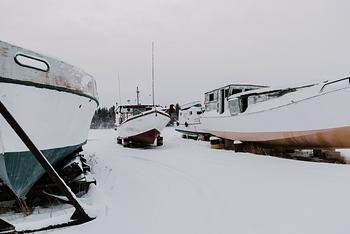
18th Oct 2023
How to Winterize a Boat: Steps, Checklist and Costs
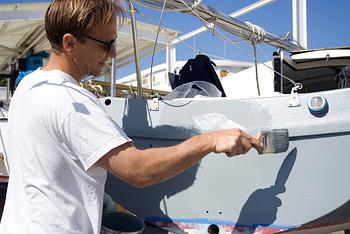
20th Sep 2023
Painting a Fiberglass Boat: A Detailed Guide
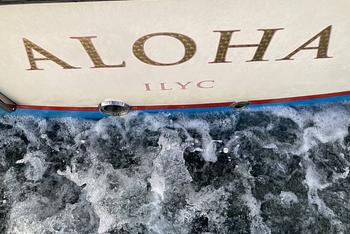
19th Sep 2023
Renaming a Boat the Proper Way
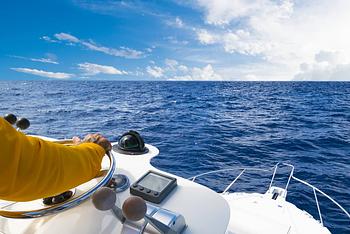
31st Aug 2023
How to Drive a Boat with Confidence
- Explore Rightboat
- Boats for Sale
- Boating Articles
- Buyers Guide
- About RightBoat
- Sell Your Boat
- Boat Selling Advice
Enter your email to keep up to date with the latest news
Join for free
Sign up now for free and discover how easy it is to keep up to date with THE latest boats for sale. Find your right boat, and tailor your voyage to finding your next boat.
Benefits of becoming a member:
- Set up tailored alerts
- Personalise your experience
- Download full specifications and broker details
- Keep tabs on your favourite boats
Are you a broker? Join as a Broker
Rightboat - join for free.
Do you have an account already? Login
Save this search
Save your search and receive new boats in your email..
You can unsubscribe from your alerts whenever you like. By pressing the button you accept the Legal Terms and conditions
Your browser (Internet Explorer 8 or lower) is out of date . It has known security flaws and may not display all features of this and other websites. Learn how to update your browser .

Boat Speed Predictions
Please note - by using this calculator you agree to the following license provisions: This calculator is for non-commercial use by the general public only. It is proved for entertainment only and not intended to be used for any other purpose. Commercial use for any reason is prohibited. A license for commercial use may be available upon application to BAM Marine on a per use or annual basis.
There are so many factors that affect boat speed that it is hard to make accurate estimates of what the real top end will be. Mercury Marine uses the following formula to estimate potential top end, this calculator uses this formula.
The Square Root of (Total Shaft Horsepower / Weight ) x Constant = Speed
The constants have been developed from experience, and are as follows:
The constants above are from close to 20 years ago. There have been so many changes in hull design that today they are not even close. To be honest our business has changed and we have not done enough recent testting to update them. The best thing to do is calculate a constant from published tests or your personal setup and go from there.
The calculator below uses the above formula. Plug in your info, and click "Calculate" on the item you want to compute. By using known values for the weight, power and speed you can come up with a more accurate constant for your boat. You can then see what effect changes to weight or power will have on top speed. Using the calculator in this fashion will produce surprisingly accurate results.
Boat Speed Calculator
Simms' CB draft rankings: No. 4 Max Melton

Simms' '24 draft rankings: Top five CB prospects

Simms' CB draft rankings: No. 5 Richardson

Simms' CB draft rankings: No. 3 D.J. James

Simms' CB draft rankings: No. 2 Nate Wiggins

Simms' CB draft rankings: No. 1 Quinyon Mitchell

Is WR becoming devalued in the NFL draft?

Why Harrison Jr. is the draft's No. 3 WR

Sleeper wide receivers in 2024 NFL Draft

Simms' WR draft rankings: No. 5 Roman Wilson

Simms' '24 draft rankings: Top five WR prospects

Simms' WR draft rankings: No. 4 Rome Odunze

Simms' WR draft rankings: No. 3 Marvin Harrison Jr

COMMENTS
Offshore V-Bottom Monohull Speed Boats. The offshore monohull V-bottom is still the quintessential high-performance powerboat. The boat's length dictates the waves you can take on safely and comfortably. Typically, high-performance V-bottom measures from 25 feet and up to over 50 feet.
The speed of speed boats can vary widely depending on their design, size, and intended use. Recreational speed boats may reach speeds of 30 to 60 miles per hour (48 to 97 kilometers per hour), while high-performance boats and racing boats can achieve speeds of 100 miles per hour (160 kilometers per hour) or more.
Features of World's Fastest Boats in 2023. 12. Outerlimits SV-52, max speed - 100 mph. Outerlimits power boats are offering a wide range of speed power boats. Their faster boat category includes the SV-50, SV-52, SL-44, SL-52 and even catamarans like the 43CAT and 48CAT. The SV-52 is one of their fastest speed boats.
High-Performance Speed Boats: The Ultimate Guide. Written by: Brett Becker on March 4, 2024. The greatest powerboats in the world - those that inspire movies and movie stars, the boats that are the most fun to drive, the boats that invite clusters of onlookers at the docks - are high-performance speed boats. Go-fast boats are the stuff of ...
Buyers can choose between Mercury Racing 565 HP Bravos or staggered 860s with #6 drives to power this model. Enthusiasts have reported exceeding 120 mph in this powerboat. Style: V-bottom. Price: Starting at $560,000. Length: 38 feet, 1 inch. Beam: 8 feet, 1 inch. Weight: 11,500 pounds. Top speed: ~120 mph. Donzi Marine 38 ZRC Full Specs. 5 ...
Above: Cigarette speed boats. Image via Marine 365/boats.com Browse on our boat listings site for new and used Cigarette 515 boats. Browse on our boat listings site for all high-performance powerboats. 5. Outerlimits SL-41 The Outerlimits SL-41 vee-bottomed, equipped with a Mercury Racing Staggered pair of 520 Engines w/ Sportmaster drives speeds of 95+mph can be achieved, and hits 56 MPH in ...
A V-hull or a boat with a planing hull runs at 47 mph. A center console achieves 65 mph. An average sailboat or yacht can go for 8 mph, but racing varieties can manage close to double that. A pontoon boat rests somewhere around 30 mph. A kayak moves at 3 mph. A houseboat, regardless of size, cruises at 11.5 mph.
In the case of a 50ft Mystic Powerboats catamaran, fast means—depending on power—200mph and beyond. Obviously, that's the extreme, and only for the extremely experienced. Most go-fast catamarans can't touch that kind of speed, but there are a slew of them out there that, again depending on power, top out at 100 to 150mph.
Today's powerboats are akin to technological marvels floating on water. The integration of high-tech navigation and electronics systems is essential for both safety and convenience. Touchscreen interfaces, GPS mapping, and radar can be found on state-of-the-art models, with technology like the Simrad GO9 XSE being an example of a top-tier ...
The Spirit of Australia: Fastest Power Boat in the World. The Guinness World Record for the top speed achieved on water is officially 275.97 knots, or over 317 mph, set by a craft called the Spirit of Australia back on October 8, 1978. It remains the record to this day, more than 40 years later. The record-setting run was at Blowering Dam Lake ...
Intrepid Powerboats - Largo, Florida; 954-922-7544; intrepidpowerboats.com. More: 2021, 40-50ft, boat tests, Boats, Cruising Boats, Intrepid Boats, November 2021, outboards. Sleek and elegant of line, and fast and foot-sure at sea, this Intrepid boasts triple outboard power, a host of amenities, and the ability to satisfy those who might ...
A powerboat is a performance boat that uses an engine for propulsion and can usually achieve high speeds if the driver or captain so wishes. Powerboats aren't just the smaller boats you see ripping across the lake on a nice day; some are the largest super yachts to hit the water today. MIA 2021 65′ 2″ FRANCHINI High Performance Sport Yacht.
The 260 Bay mixes knifelike handling with numerous fishing amenities. Courtesy Velocity Powerboats Engine. Clearing the no-wake zone, we slammed the throttle forward, and the 260 smoothly leapt onto plane, a Mercury 350 Verado outboard with lab-finished prop continuing to pour on the coal till the boat peaked at 65.9 mph. Dropping the trim a few notches and cranking the wheel at speed, we came ...
Powerboat Speed Record: The current powerboat speed record is held by the Team Australia boat, which achieved a top speed of 511.11 kilometers per hour (317.60 miles per hour) on November 20, 2018. The record-breaking run took place on Lake Dumbleyung in Western Australia. ... However, the maximum speed for a sailboat is 185 km or 115 miles. So ...
Watch on. It is precisely this fuel economy that drew the Monaco institution to choose this unique and exclusive watercraft. In this vessel size, the A2V concept of aerodynamic sustentation offers the best sea-proven answer to the need for speed, comfort, reliability and environment friendliness. A2V-25-CB - 25 passengers Crew Transfer Vessel.
SUBSCRIBE OUR CHANNEL https://www.youtube.com/c/theboatshow/?sub_confirmation=1 Extreme speed ride with Powerboat Legend Steve Curtis on board catamaran Oute...
The former editor-in-chief of Sportboat magazine and editor at large of Powerboat magazine, Trulio has covered the go-fast powerboat world since 1995. Since joining boats.com in 2000, he has written more than 200 features and blogs. In old-school offshore powerboat racing, the driver wasn't a big factor. With today's shorter courses, those ...
Below are the average and top speeds for three of the most common types of boats: sailboat, pontoon, and cruiser: 317.6mph (511 km/h) was the fastest boat speed ever recorded. Back in 1978, a speedboat used a jet engine (instead of a propeller) to power the boat. In decades past, cigarette boats or rum-runners were motorboats designed for fast ...
Calculate the speed of a racing hydroplane having an engine that delivers 3000 hp and displaces 6800 pounds of water.. To calculate boat speed:. Step 1: Enter shaft horsepower value P = 3000 hp.. Step 2: Insert the boat's displacement, D = 6800 lbs.. Step 3: Choose the Crouch constant, C from the list for hydroplanes, i.e., C = 220.. Step 4: Using the Crouch's formula:
Class1 offshore powerboat. Offshore powerboat racing is a type of racing by ocean-going powerboats, typically point-to-point racing.. In most of the world, offshore powerboat racing is led by the Union Internationale Motonautique (UIM) regulated Class 1 and Powerboat P1. In the US, offshore powerboat racing is led by the APBA/UIM and consists of races hosted by Powerboat P1 USA.
At a steady cruising speed of 7 MPH, the 240 Bowrider consumes about 3 gallons of fuel per hour. At twice that speed, around 15 MPH, it consumes over twice the amount of fuel, burning up around 7 gallons per hour. Double that speed again and the boat consumes 11 gallons of fuel at around 30 MPH. The Bowrider can go well over 45 MPH.
Your boat should be doing no more than idling. Slow speed, minimum wake: Your boat must be fully off plane and settled in the water, creating a minimal wake. Maximum 25mph, 30mph and 35mph speed zones: Boaters must not, by law, exceed these speed enforcement signs in the designated areas.
There are so many factors that affect boat speed that it is hard to make accurate estimates of what the real top end will be. ... (For max top speed) Heavy V bottom: Low drive height, cabin, side by side engines: 225: 10 - 13 %: Fast V bottom: High Drives, boxes, notched transom, good bottom: 250:
Chris Simms believes CB Max Melton's "straight speed" and acceleration are as good as anyone in the draft and views him as someone coaches can trust "on an ... J. James possesses elite "change of direction skills" that make him a special player despite not having the downfield speed as the CBs ranked ahead of him. 10:17. Simms' CB draft ...